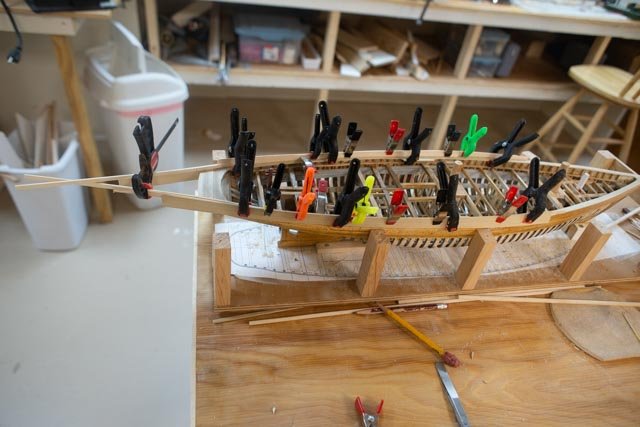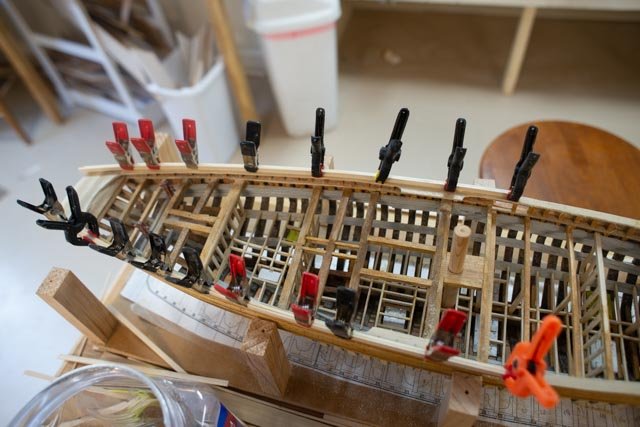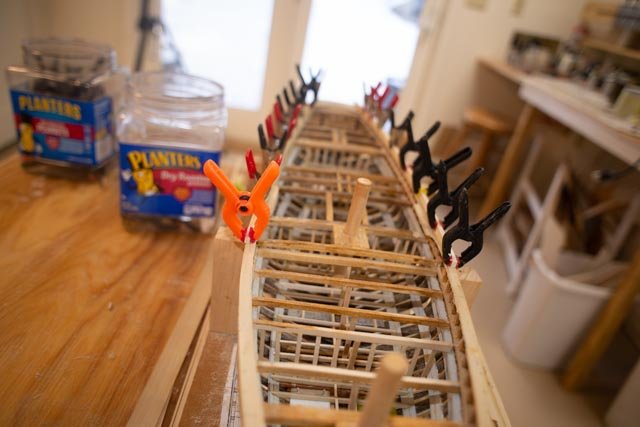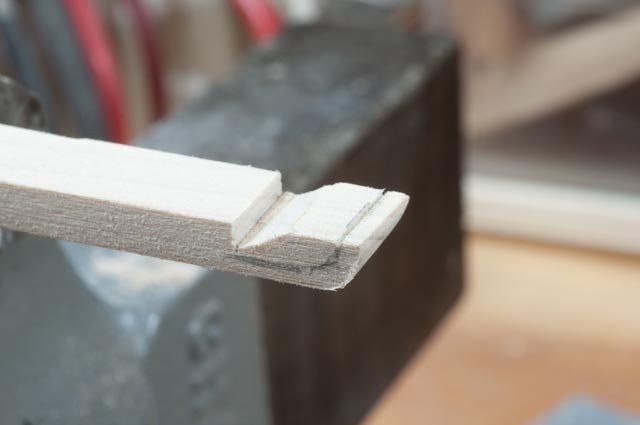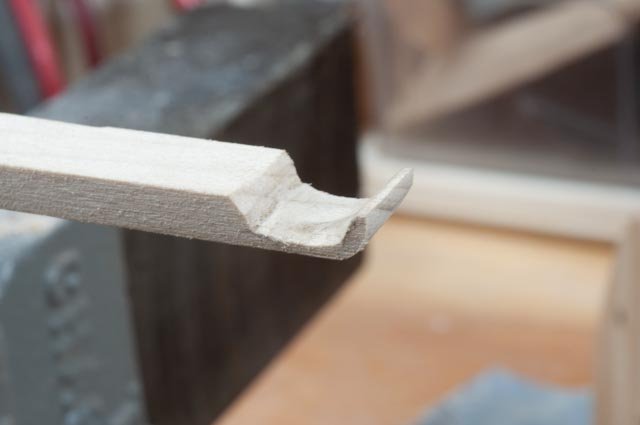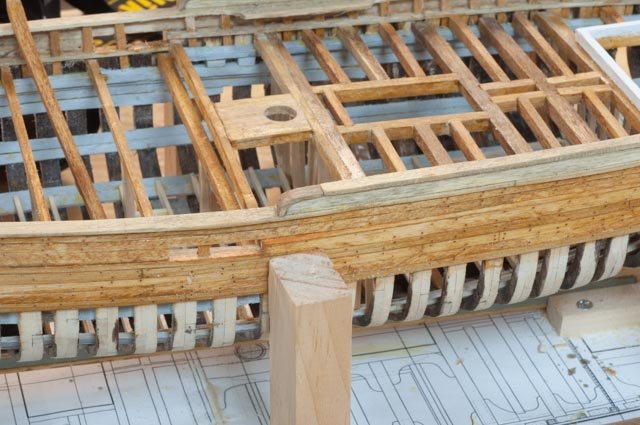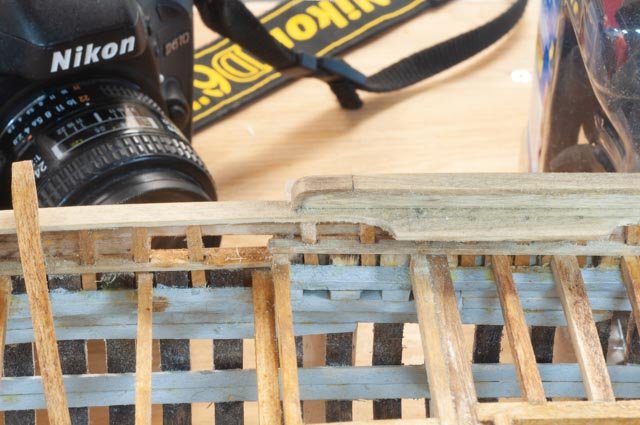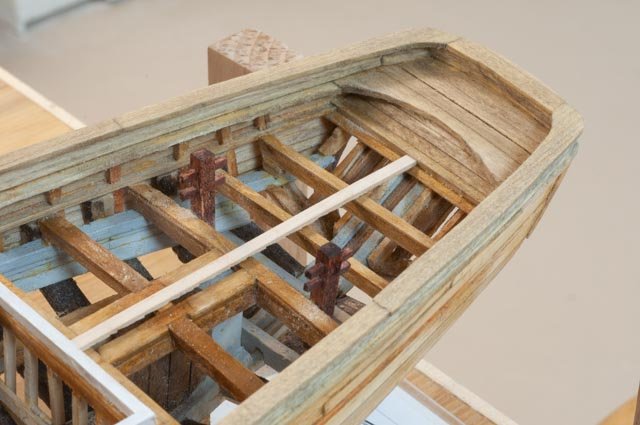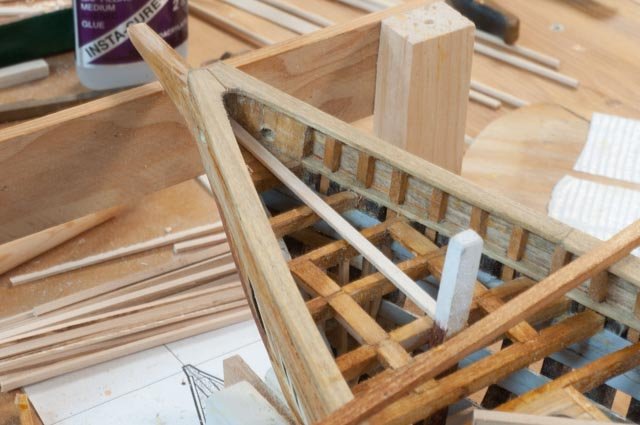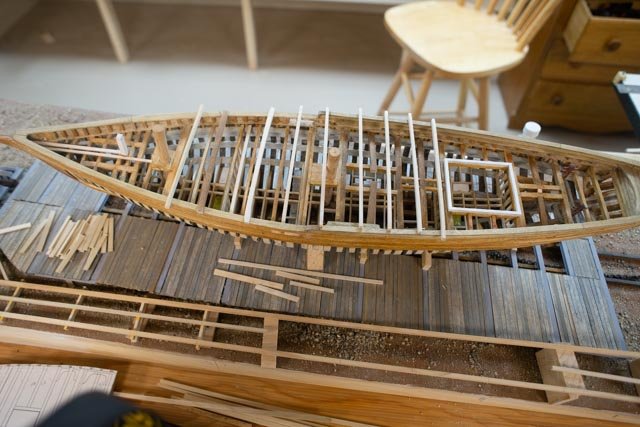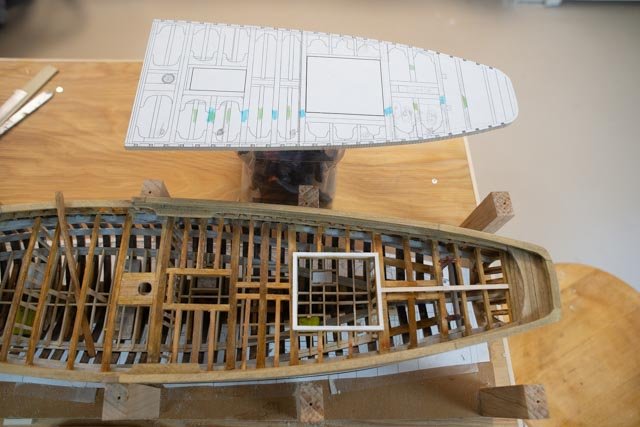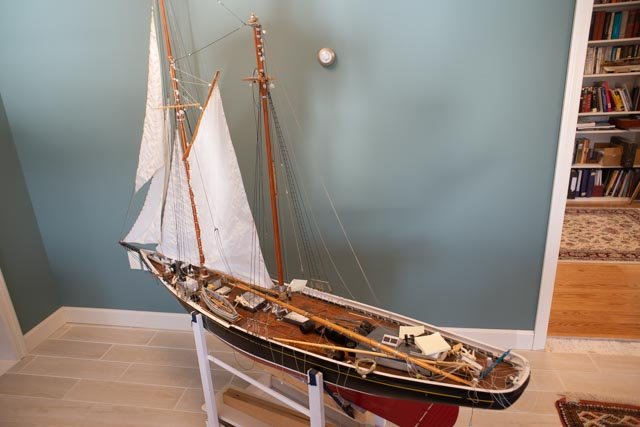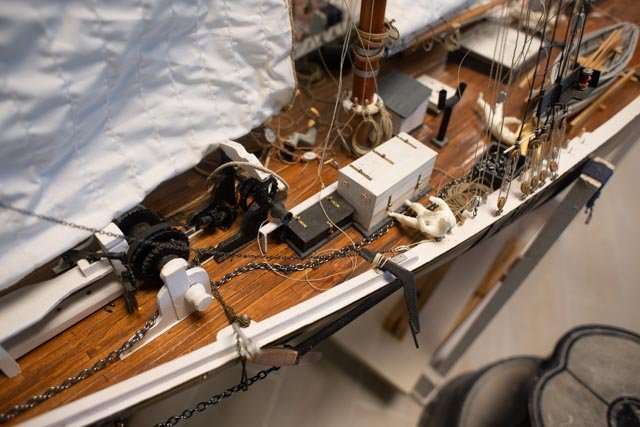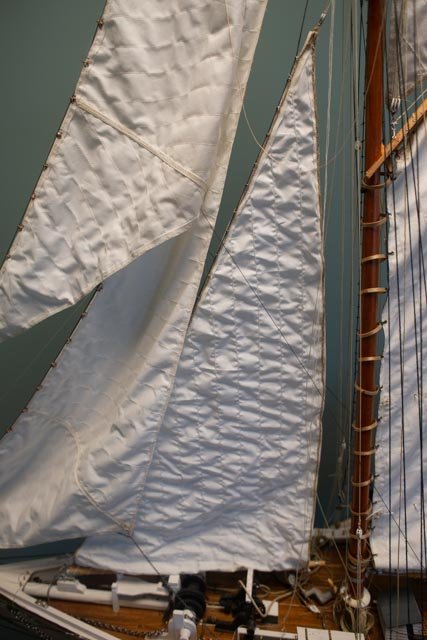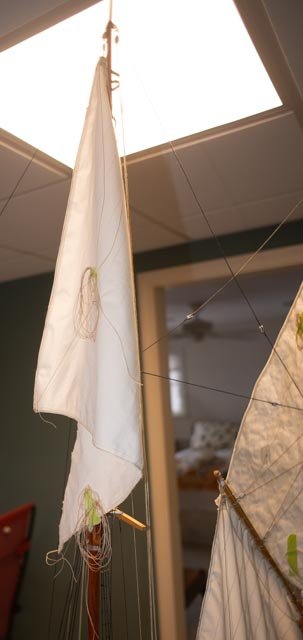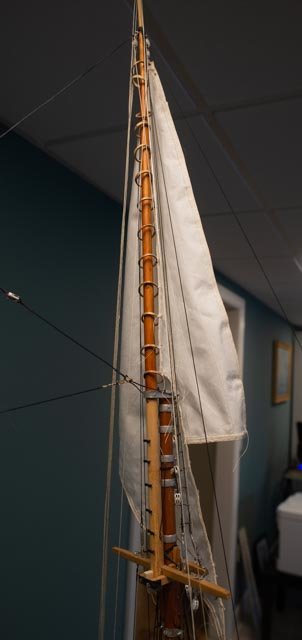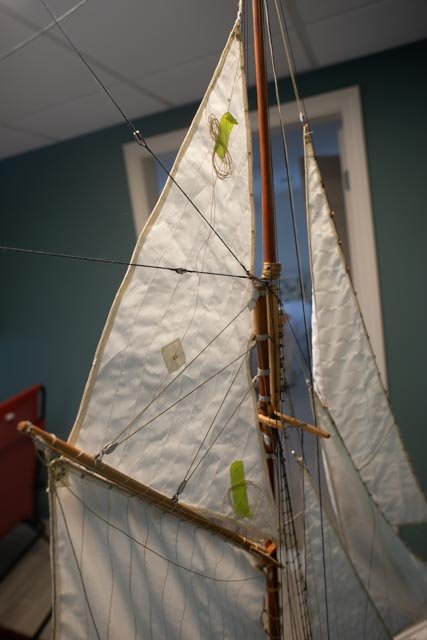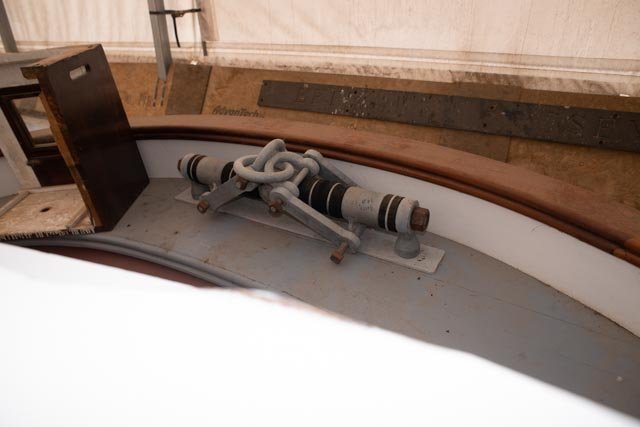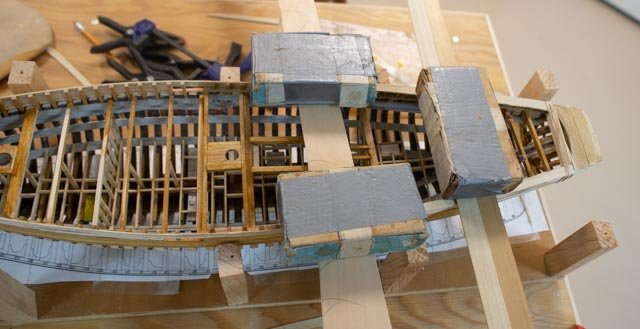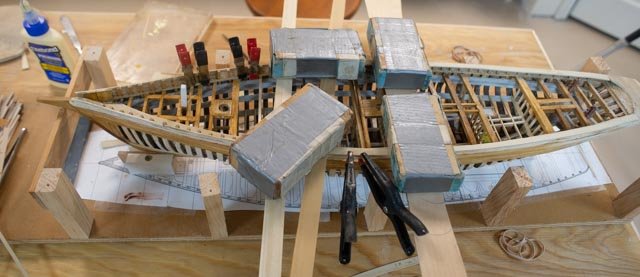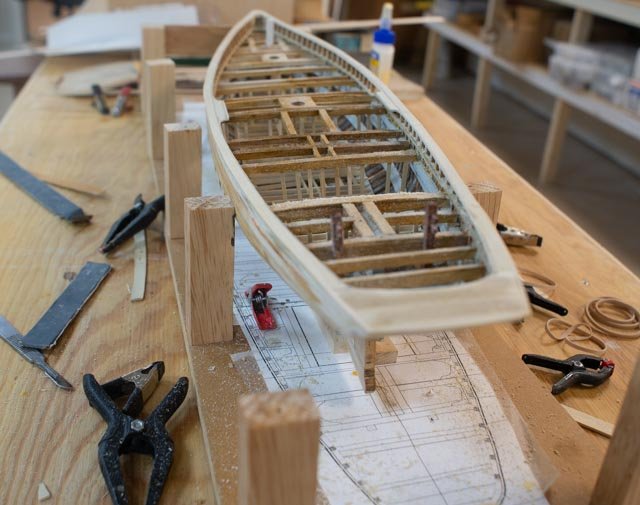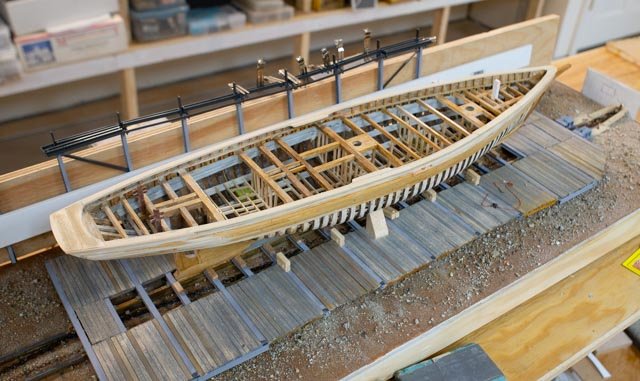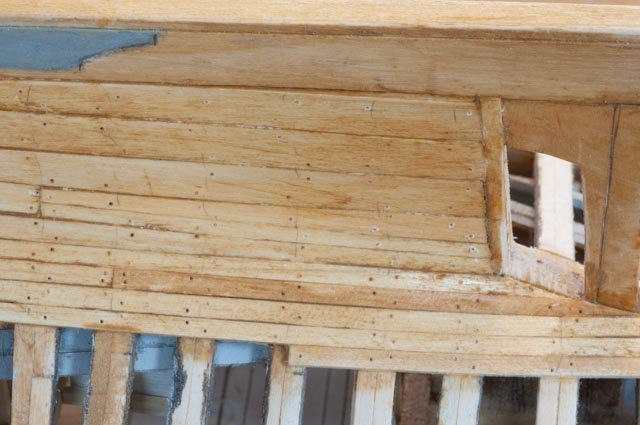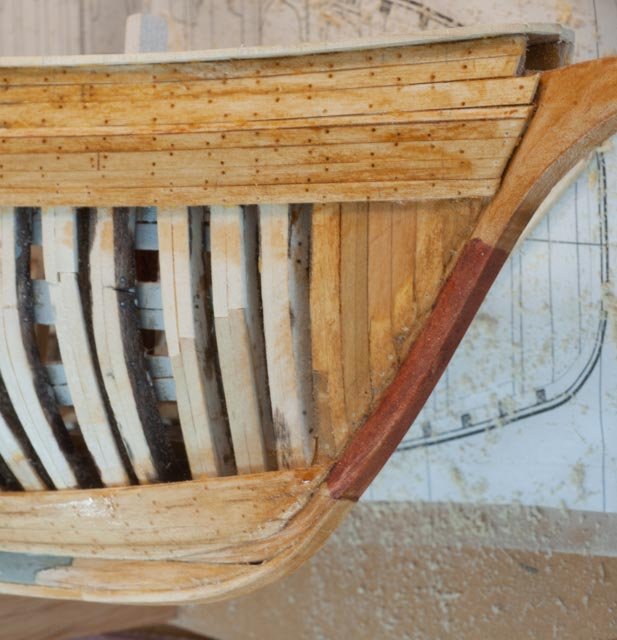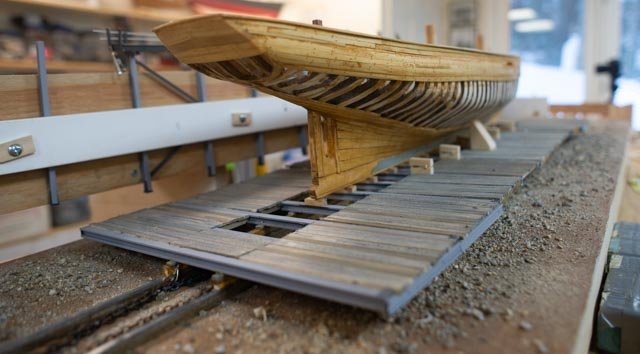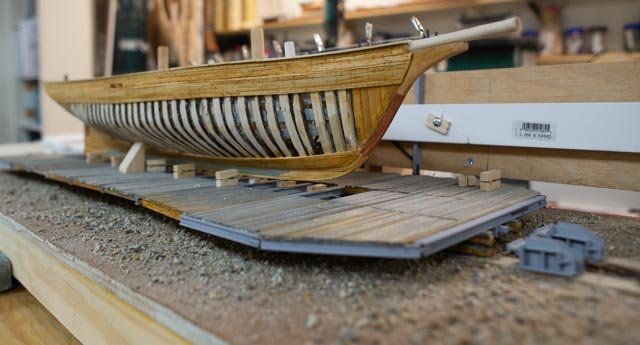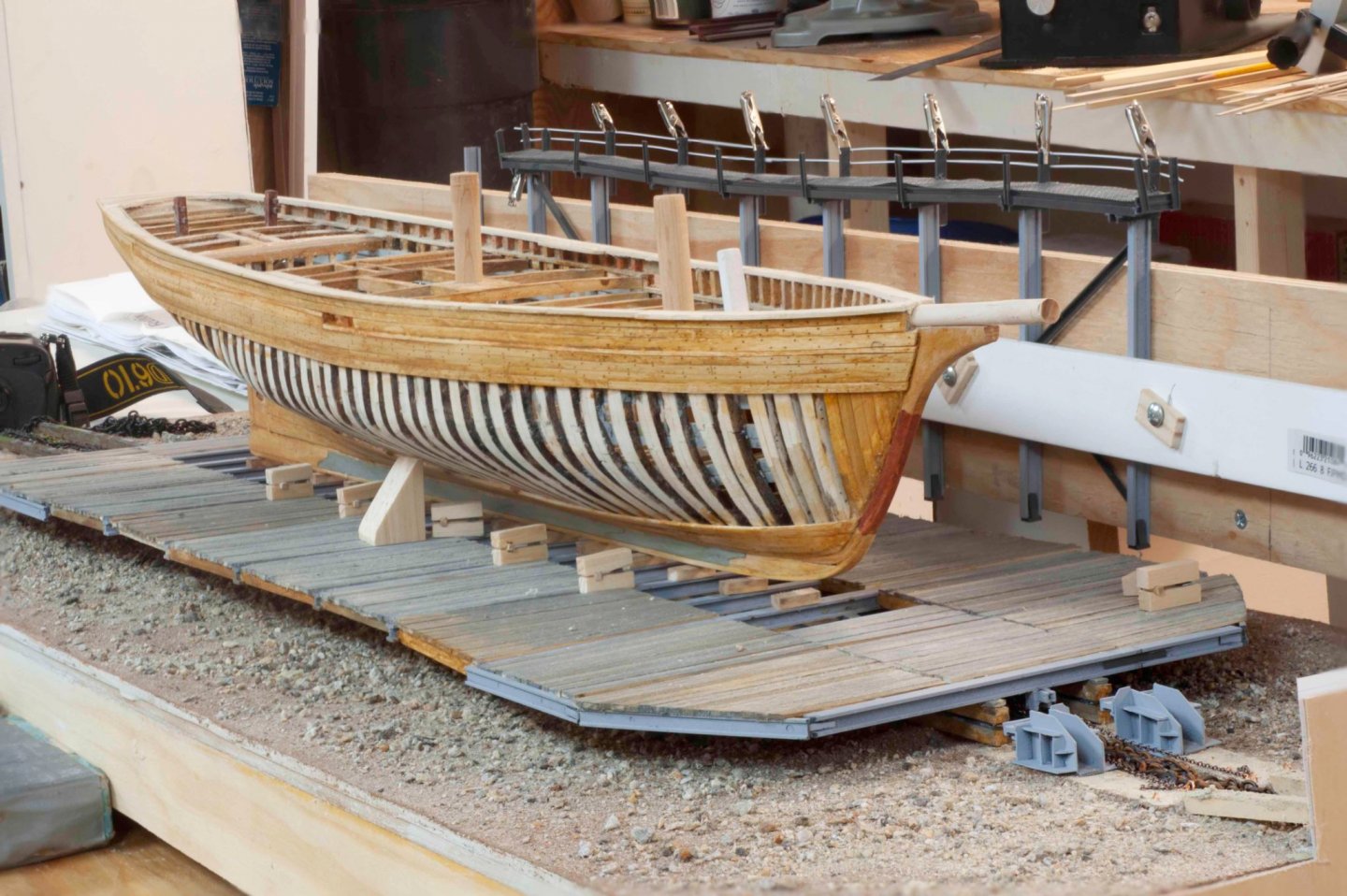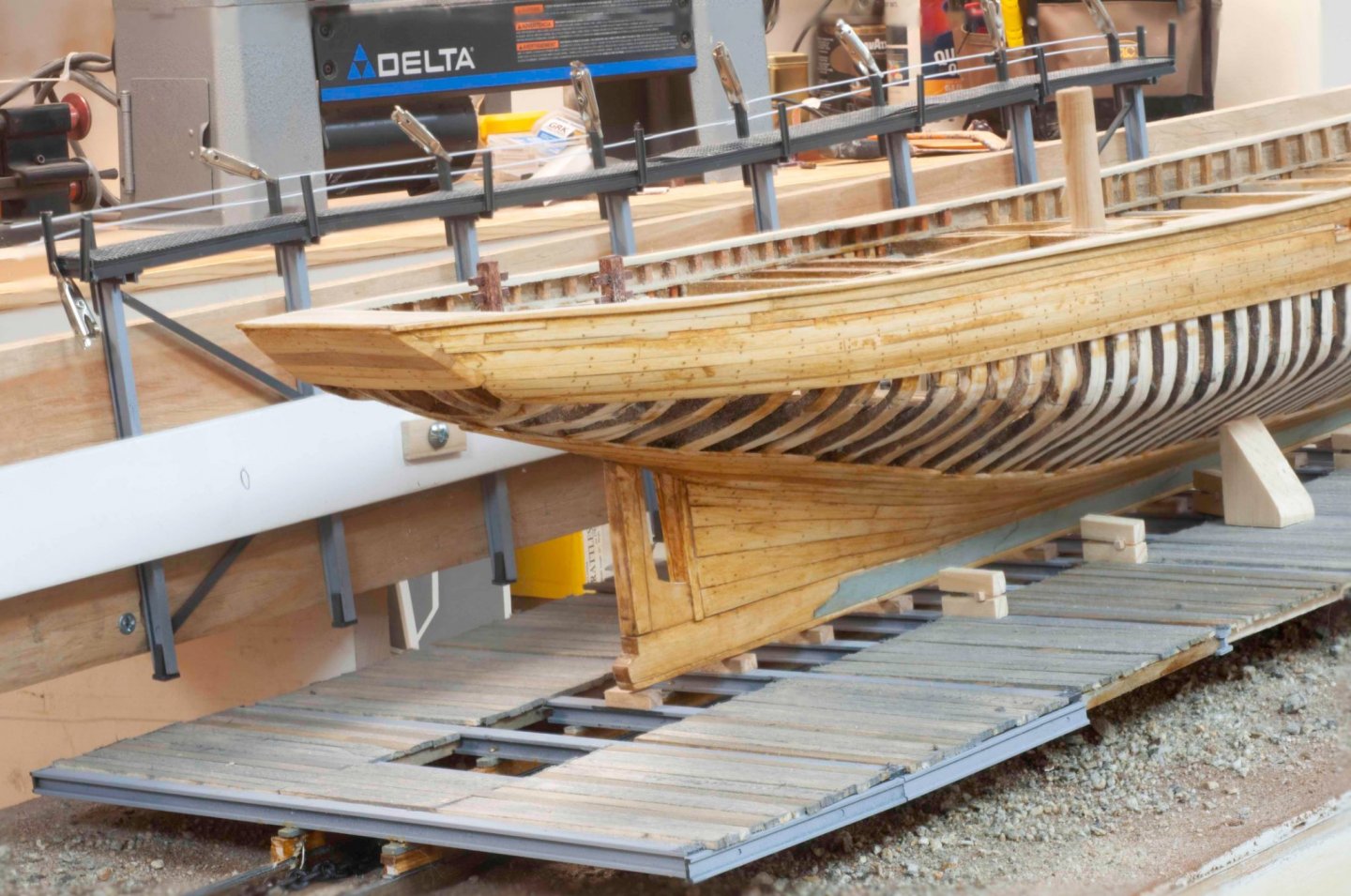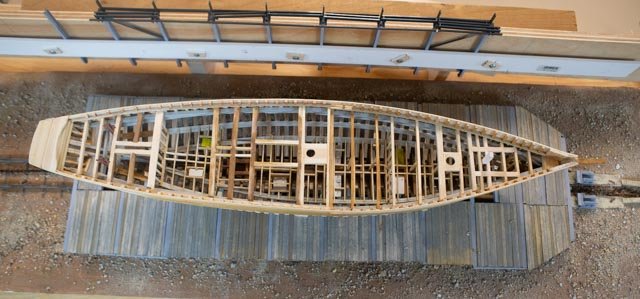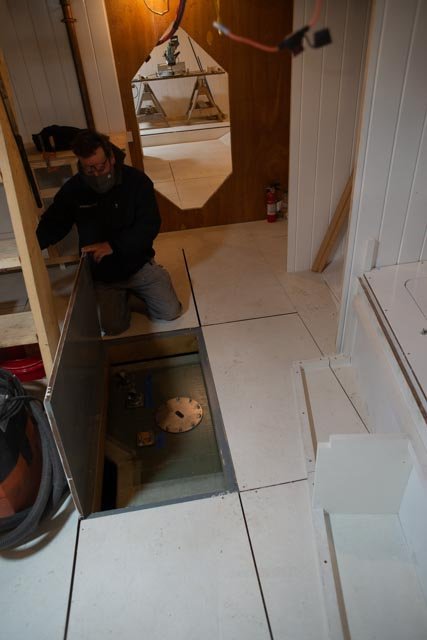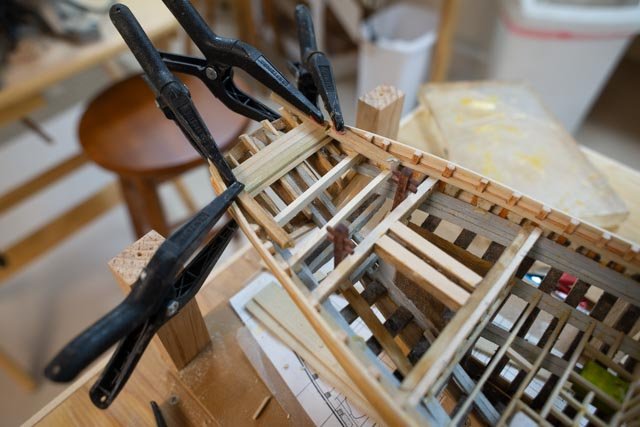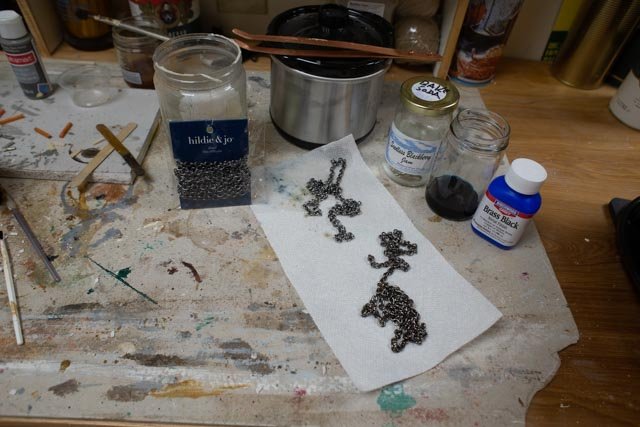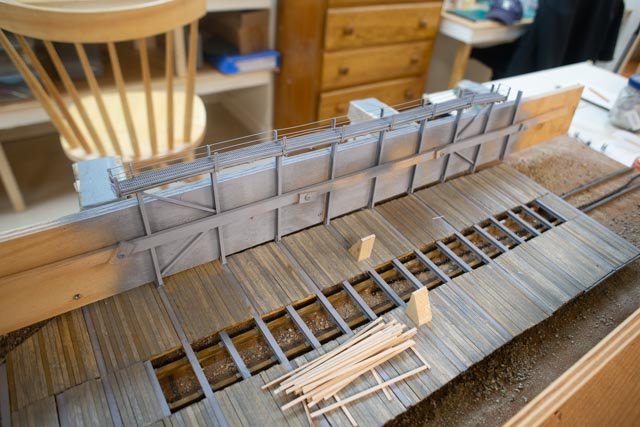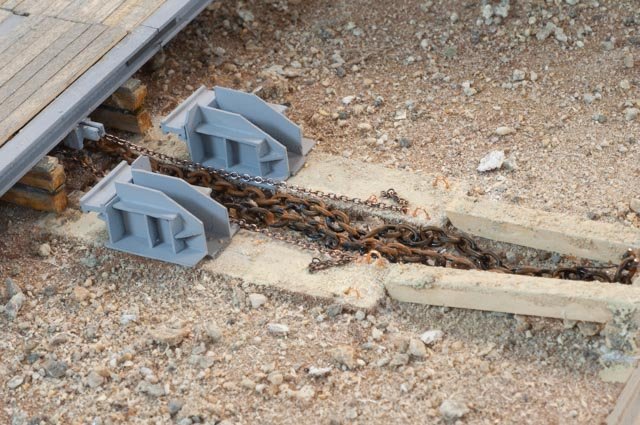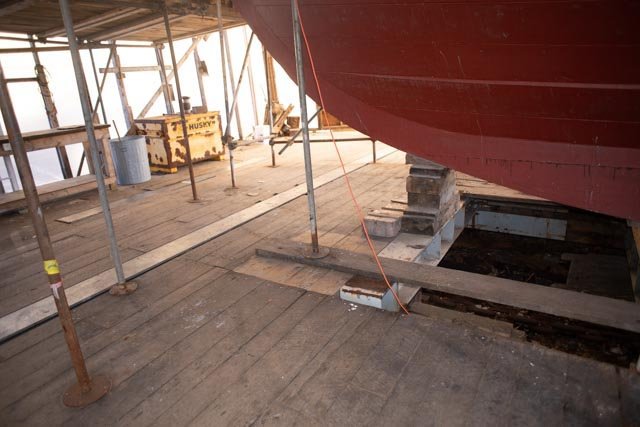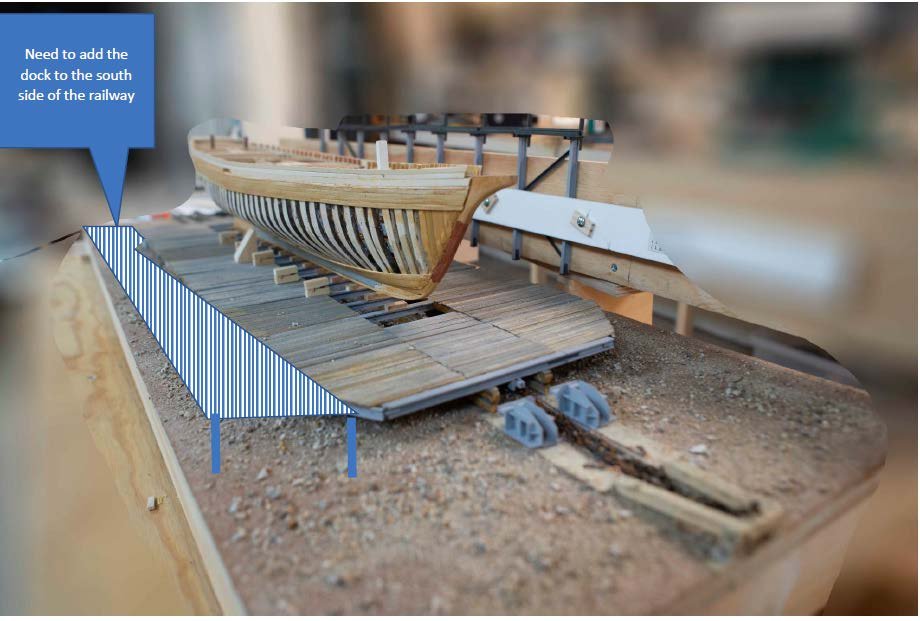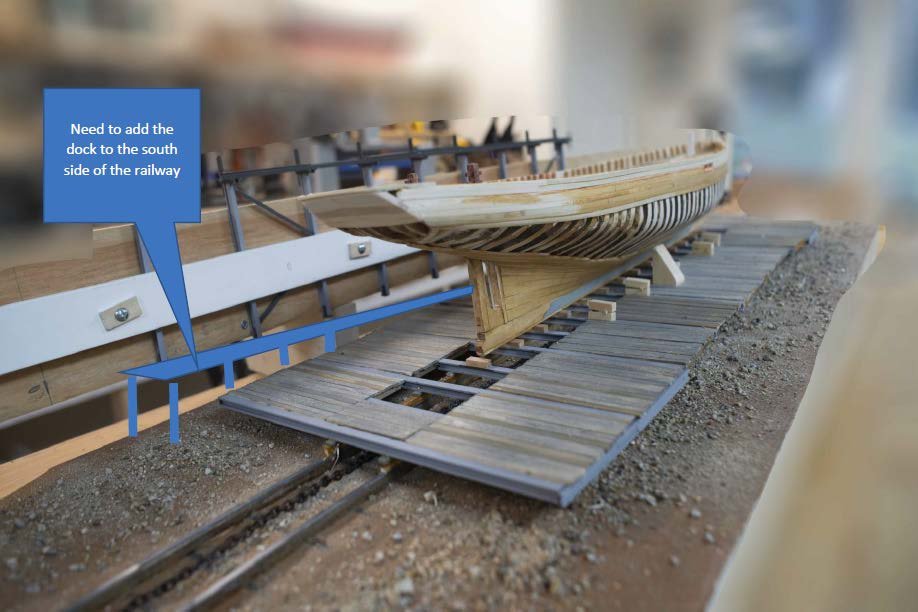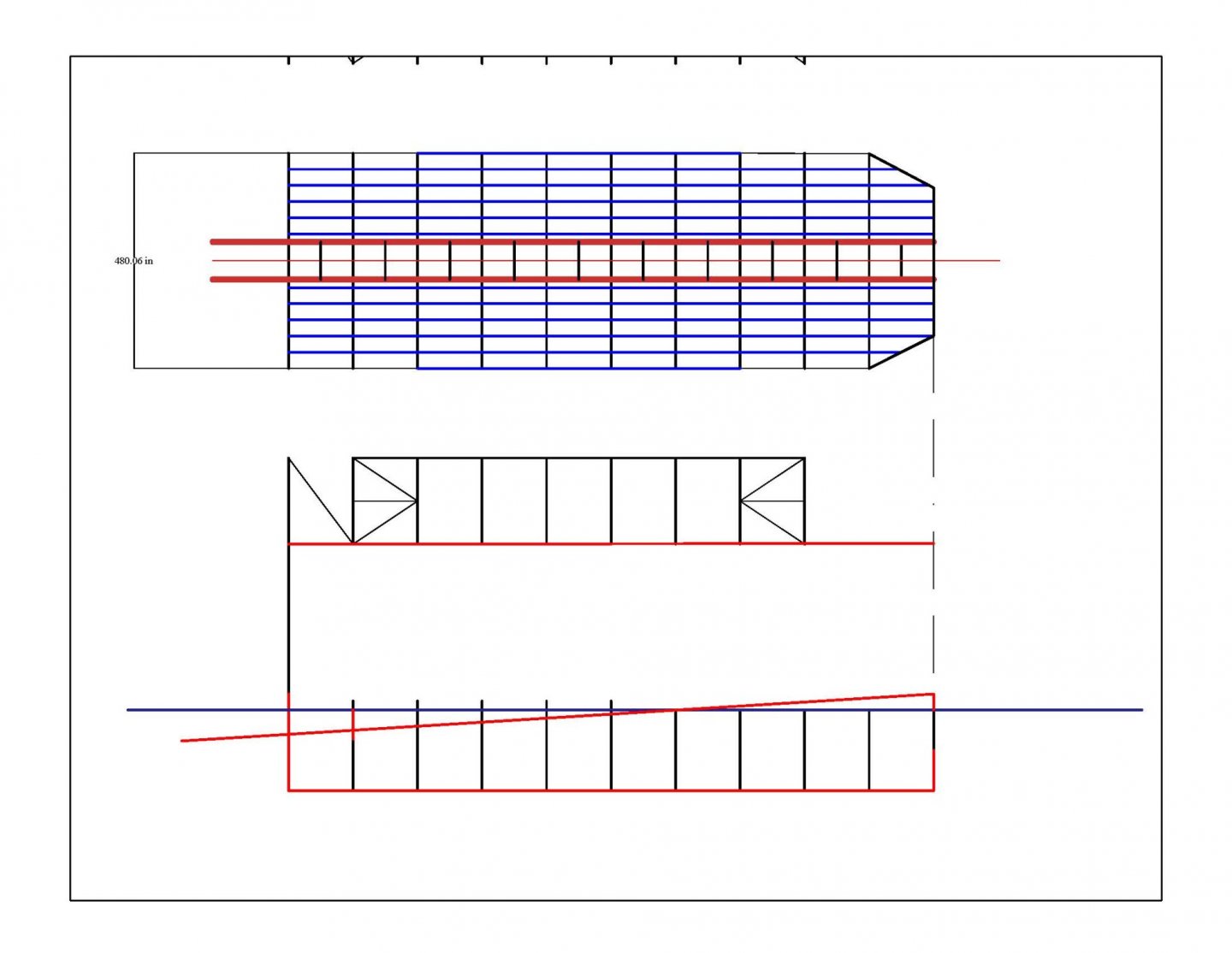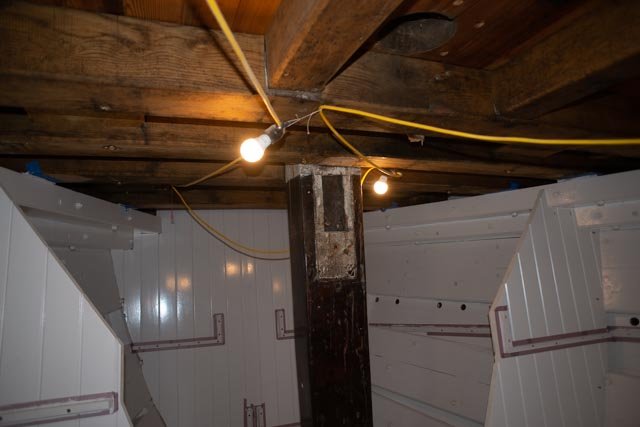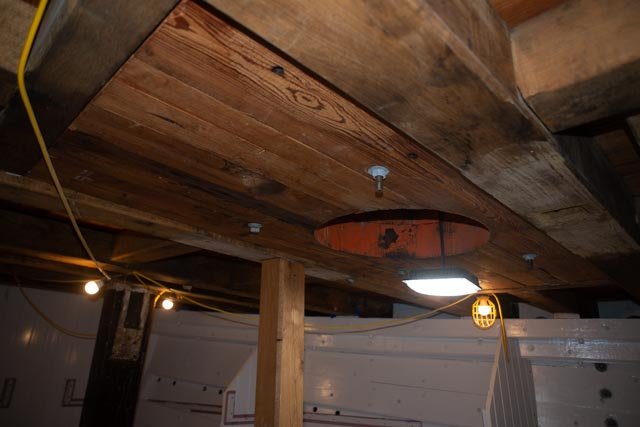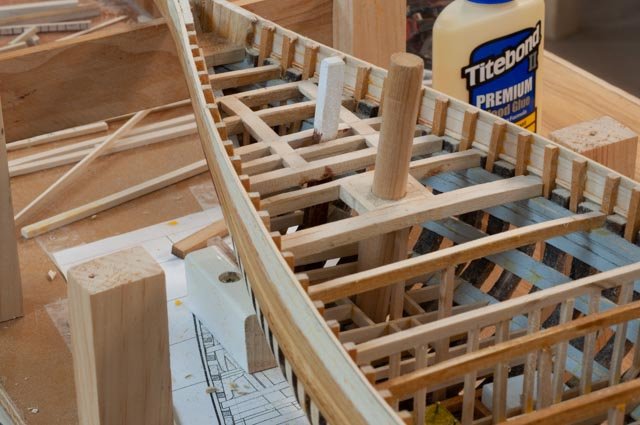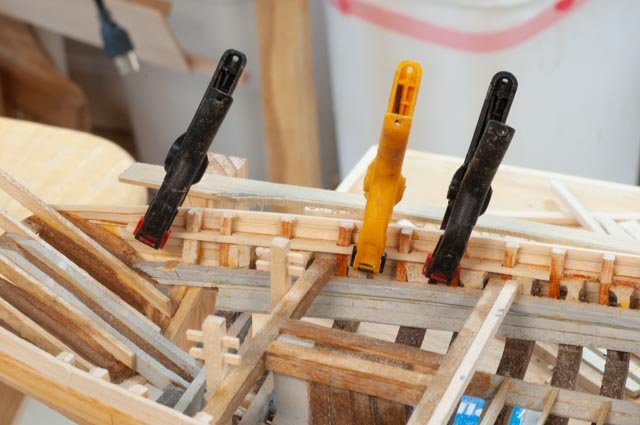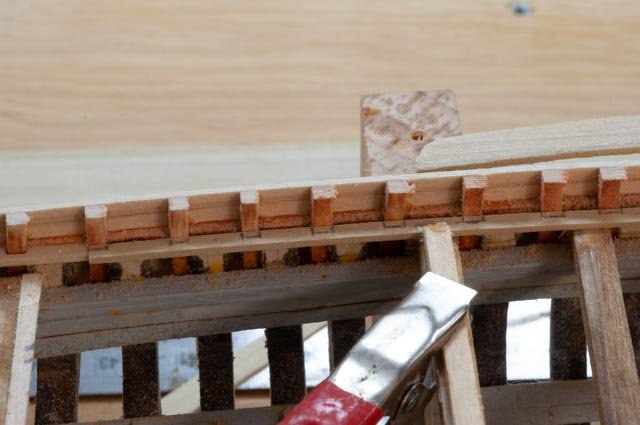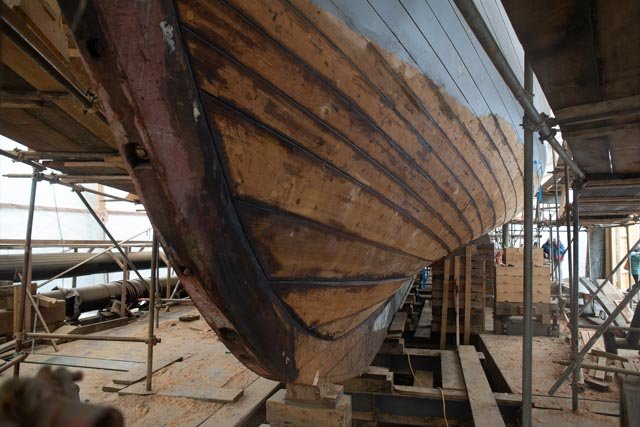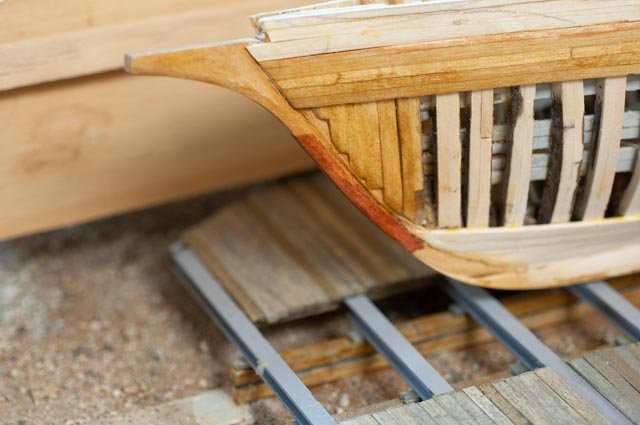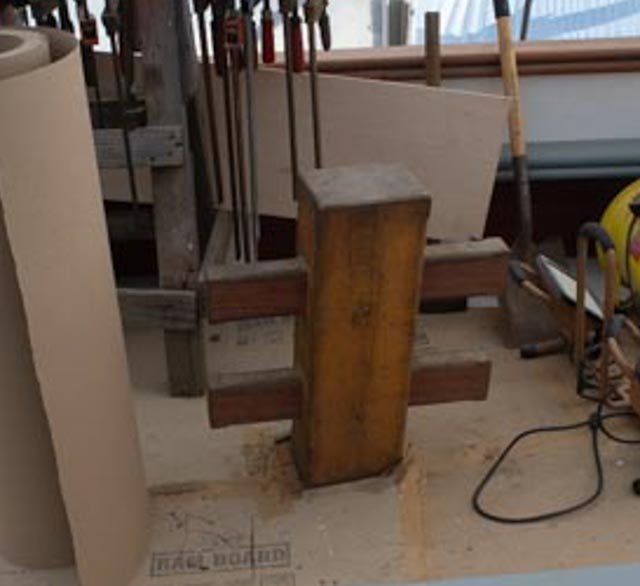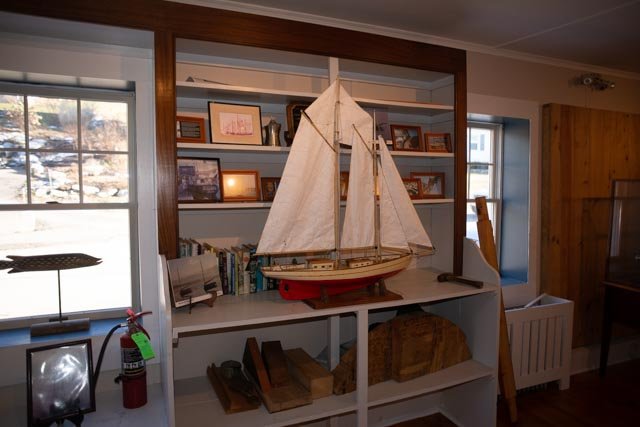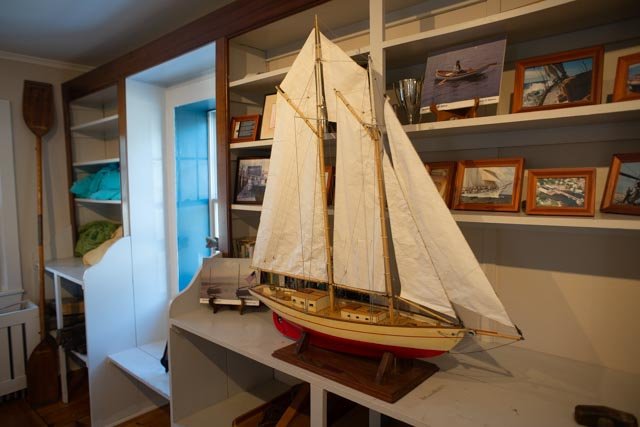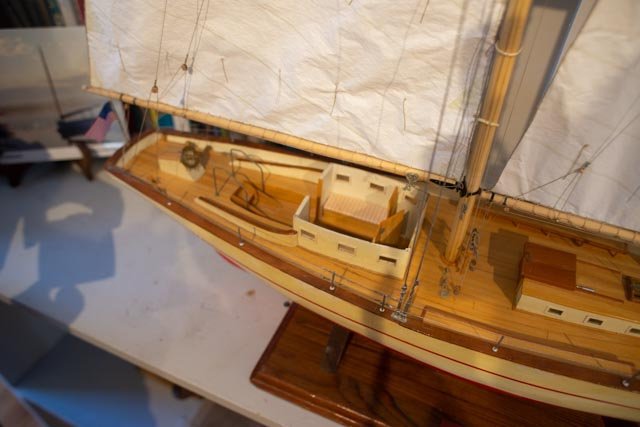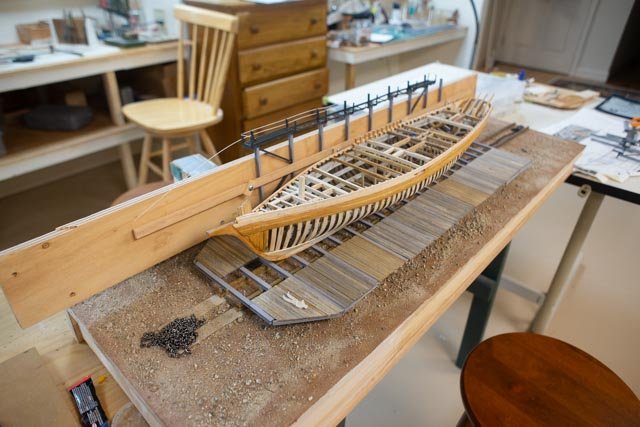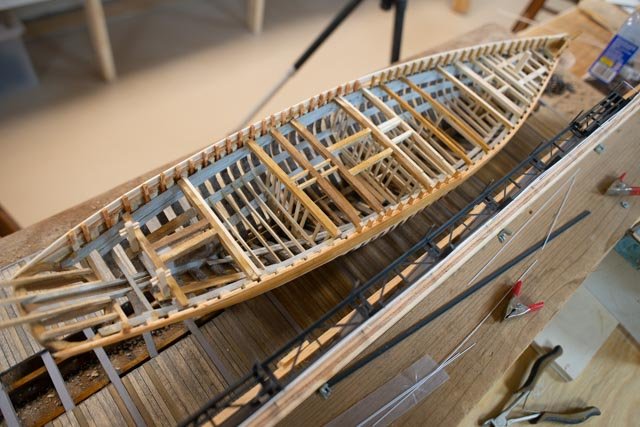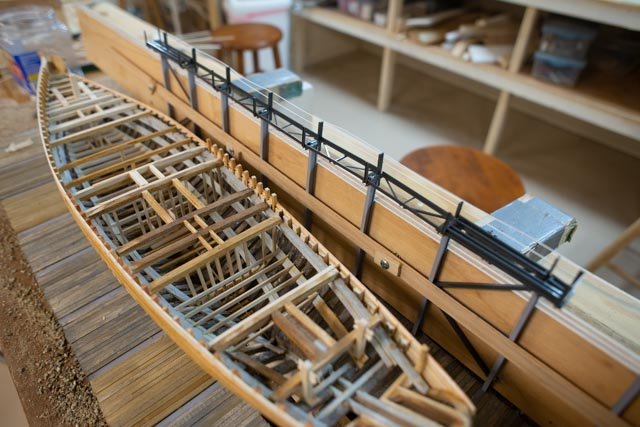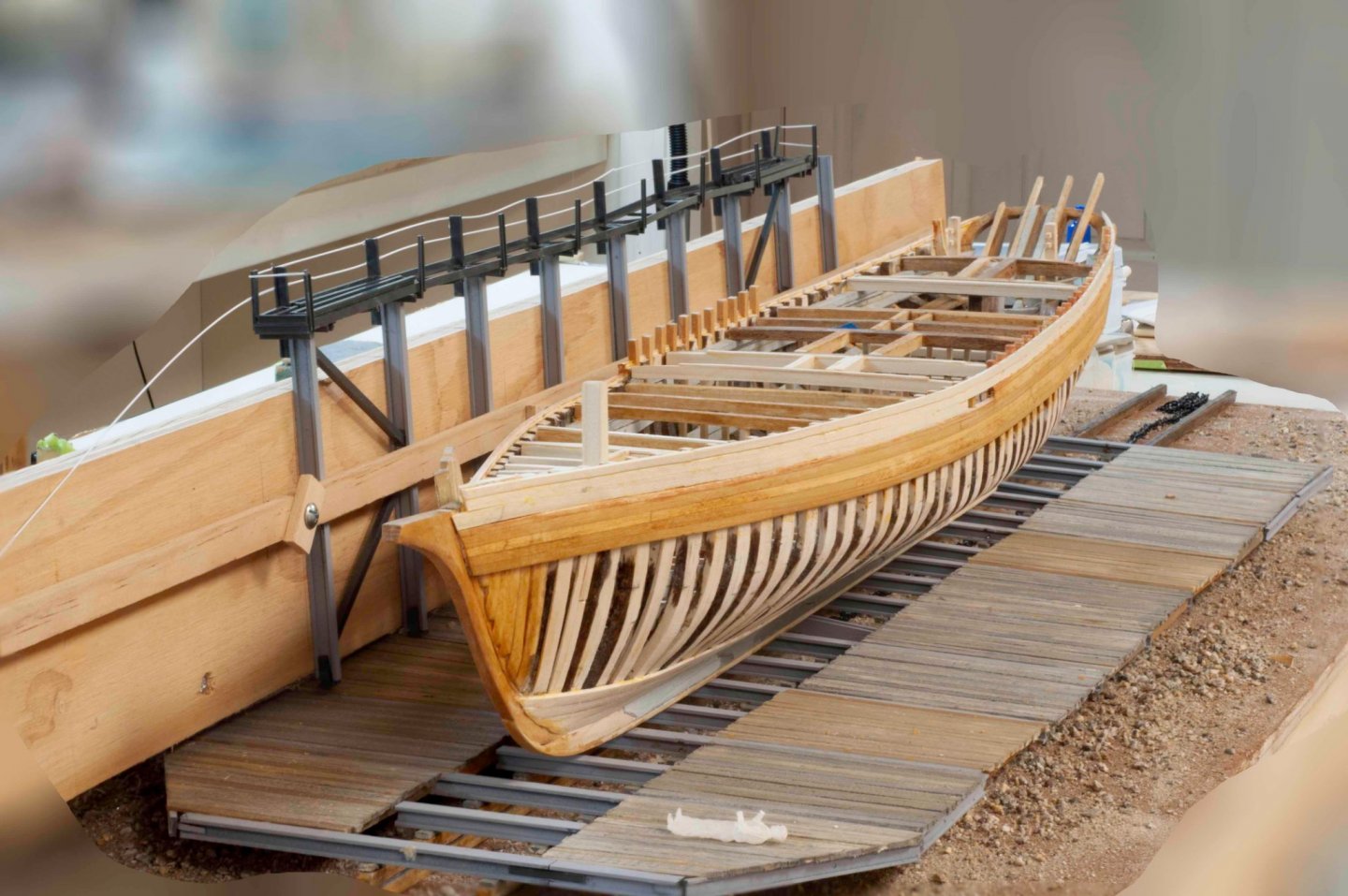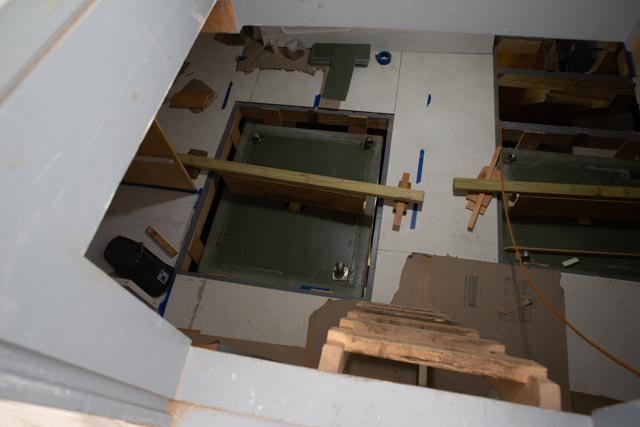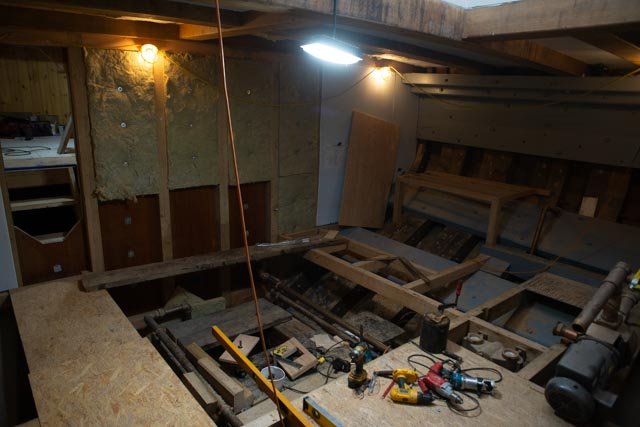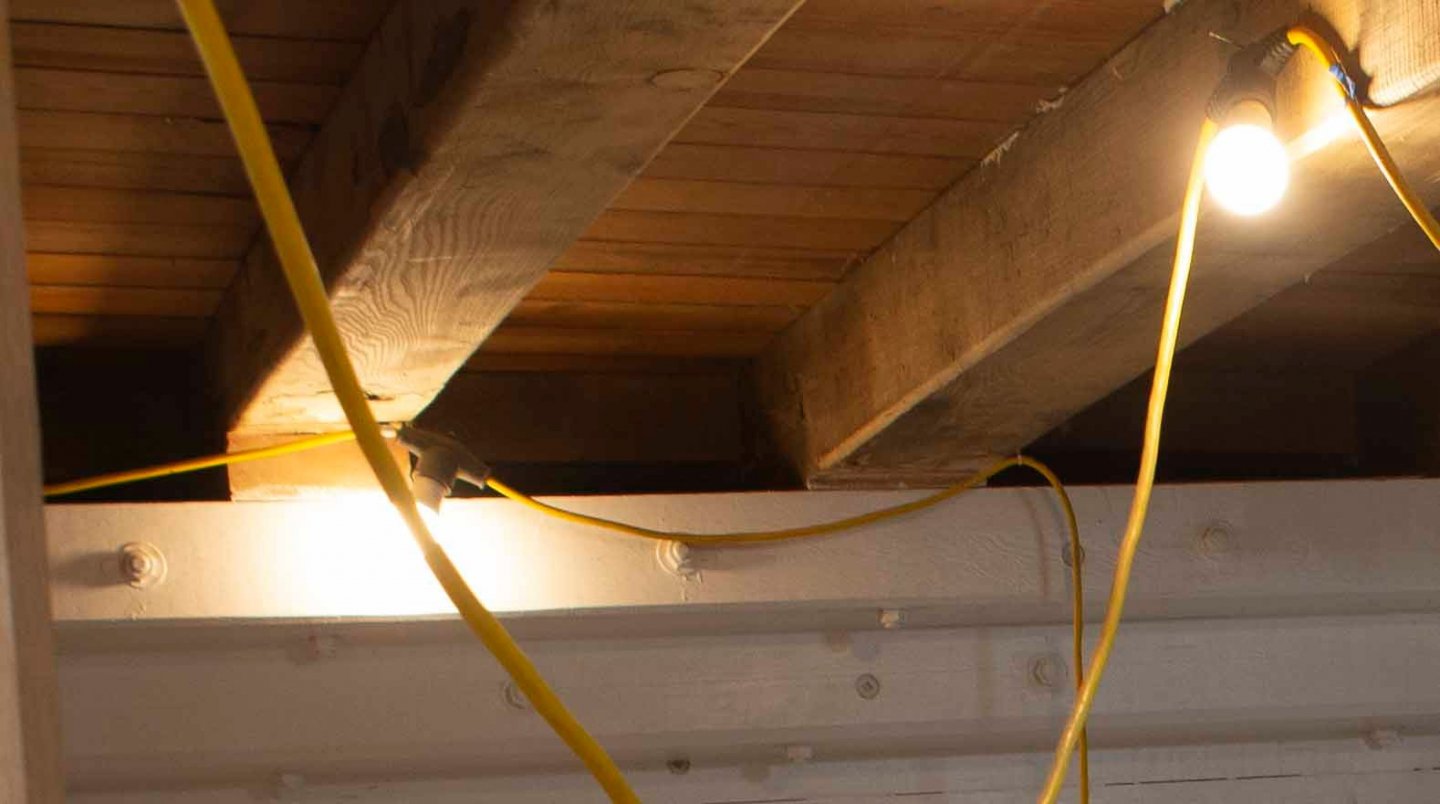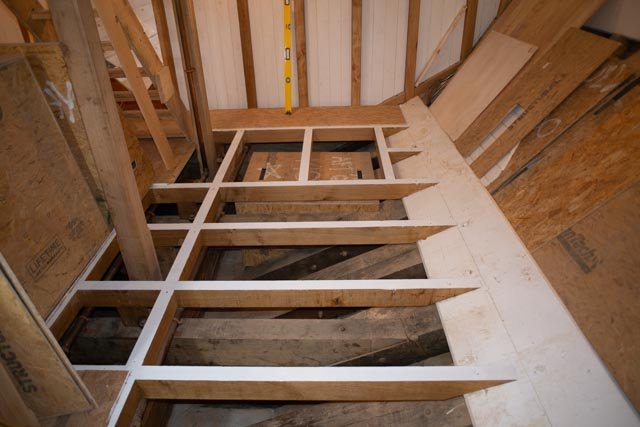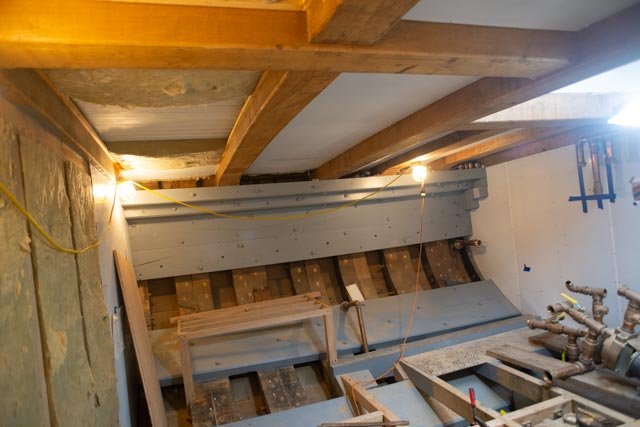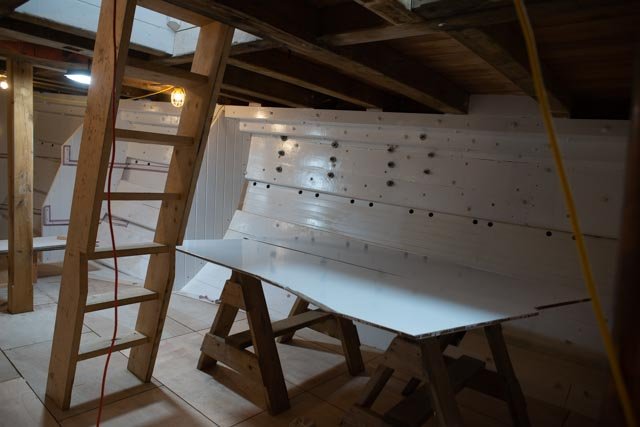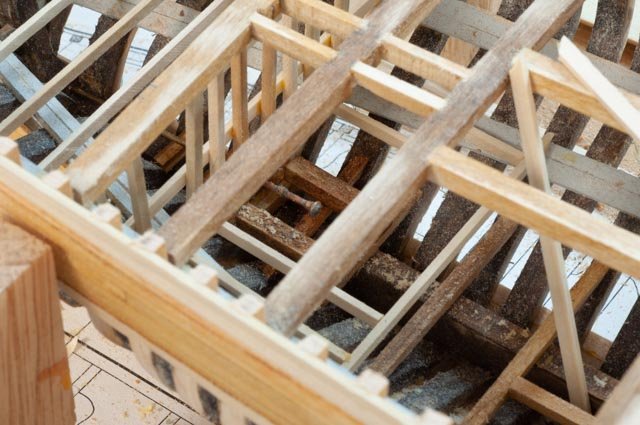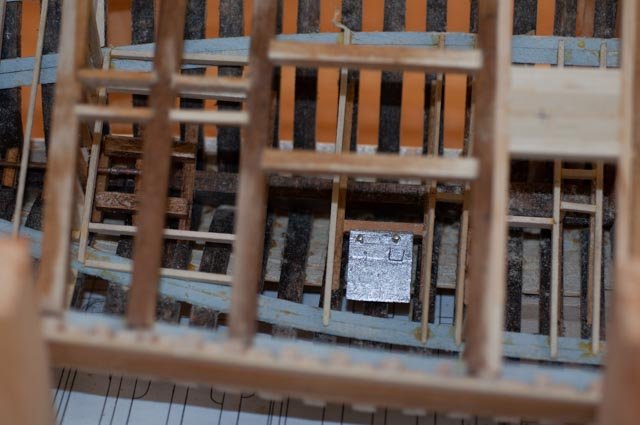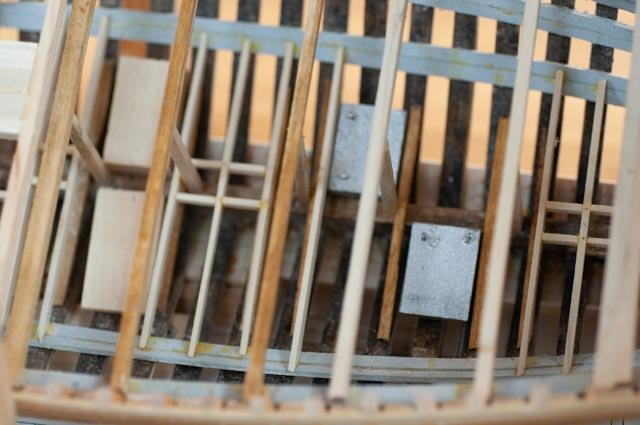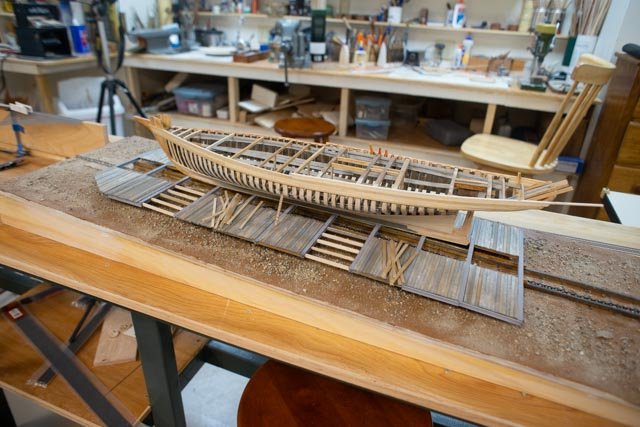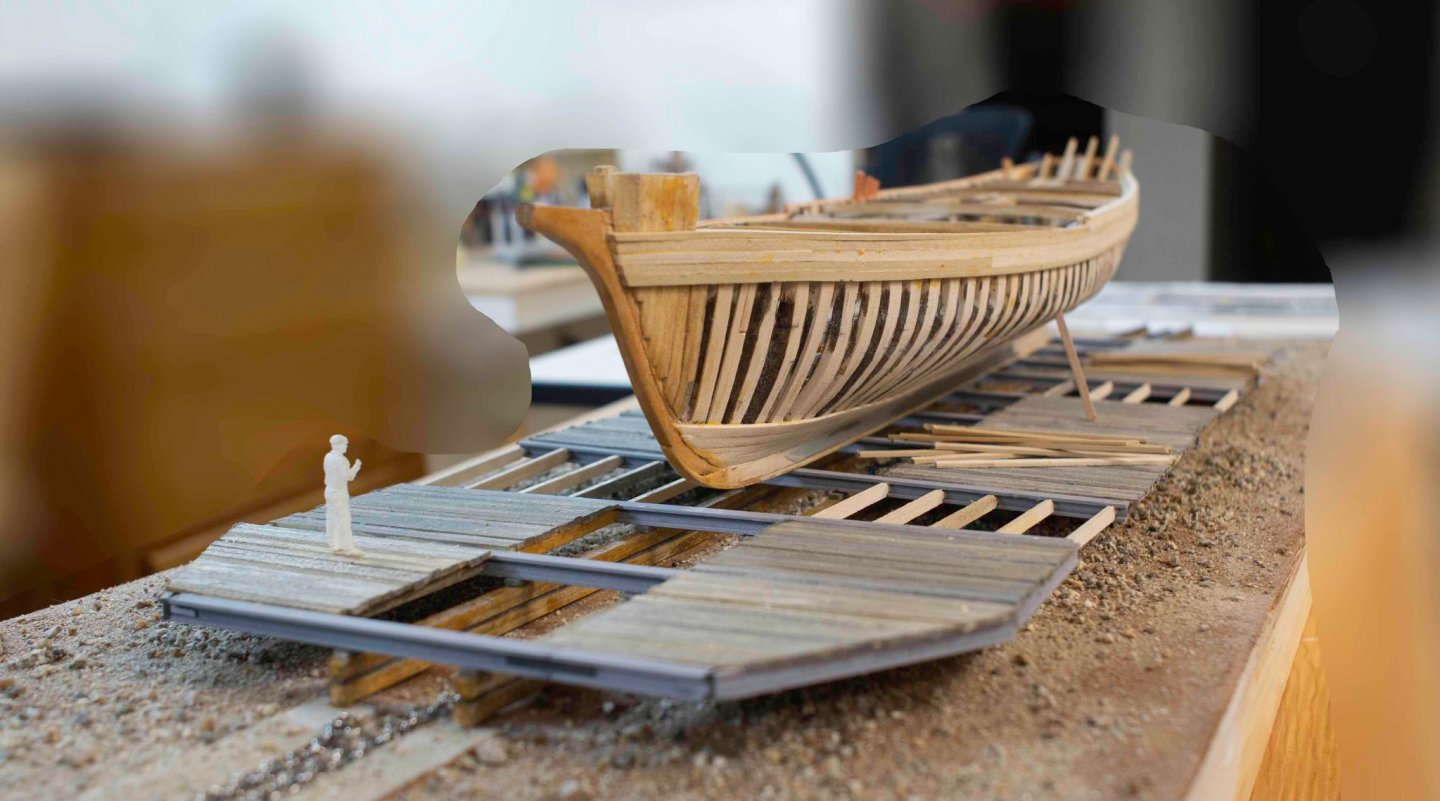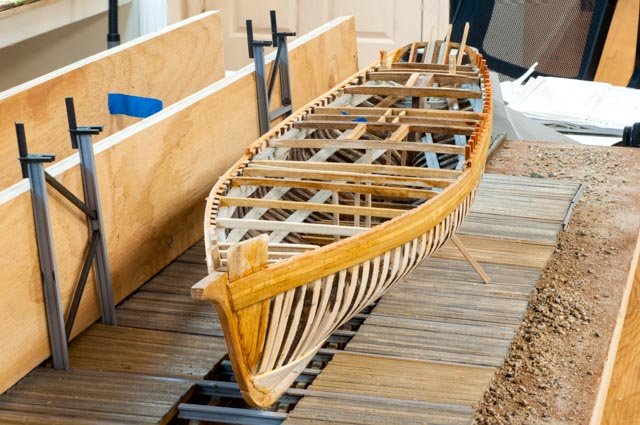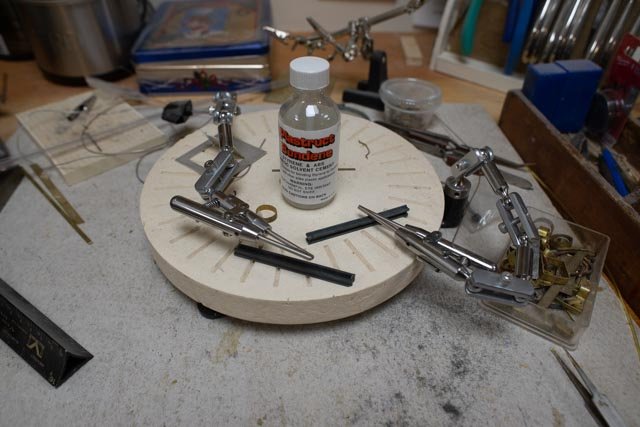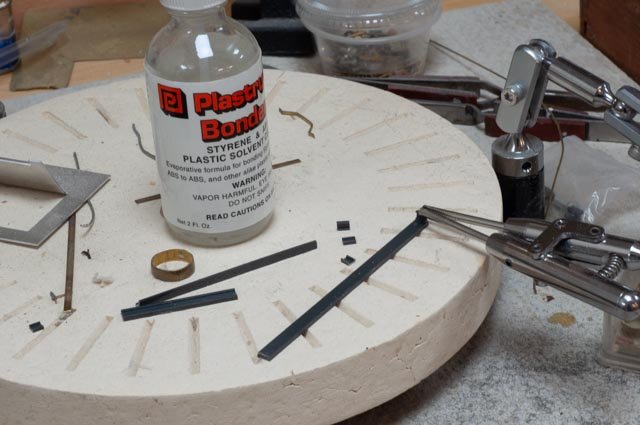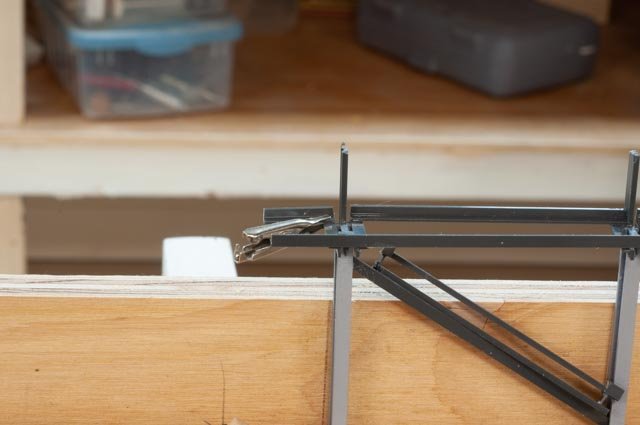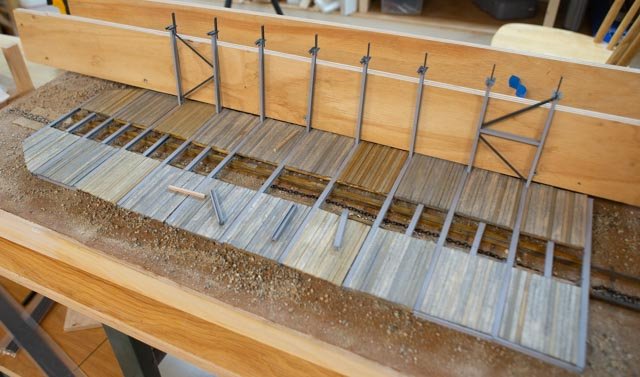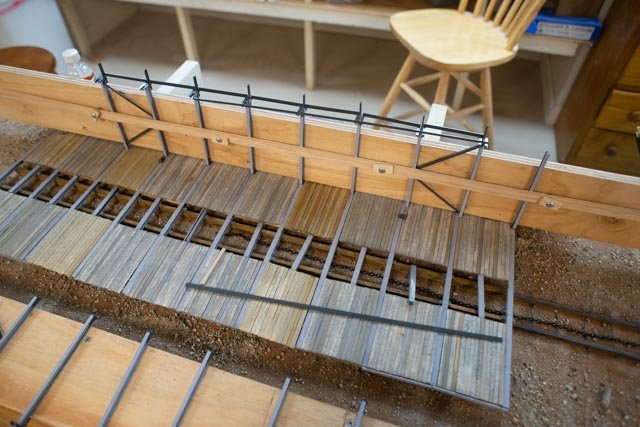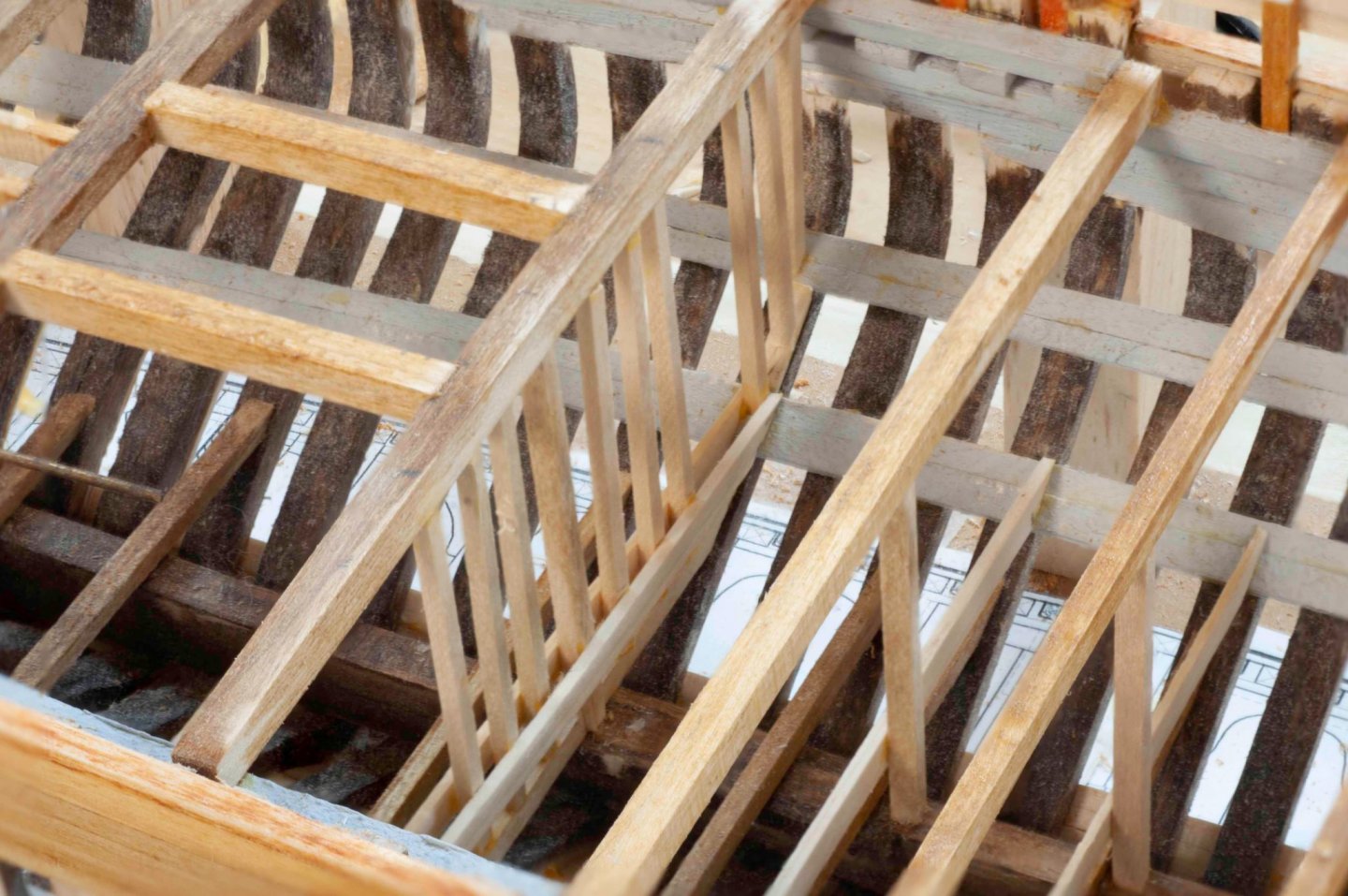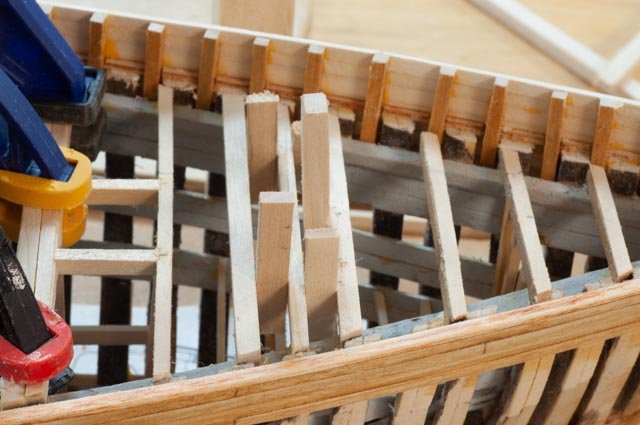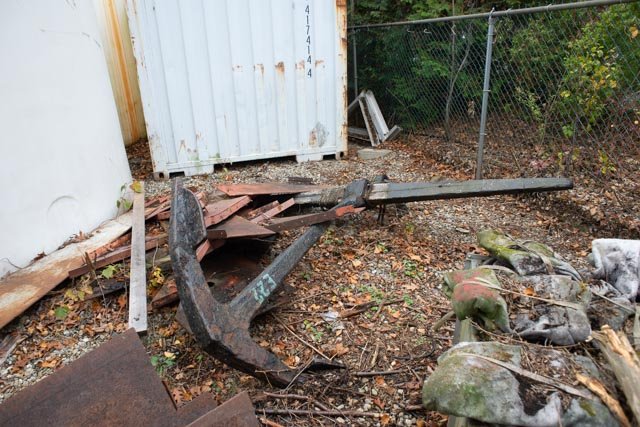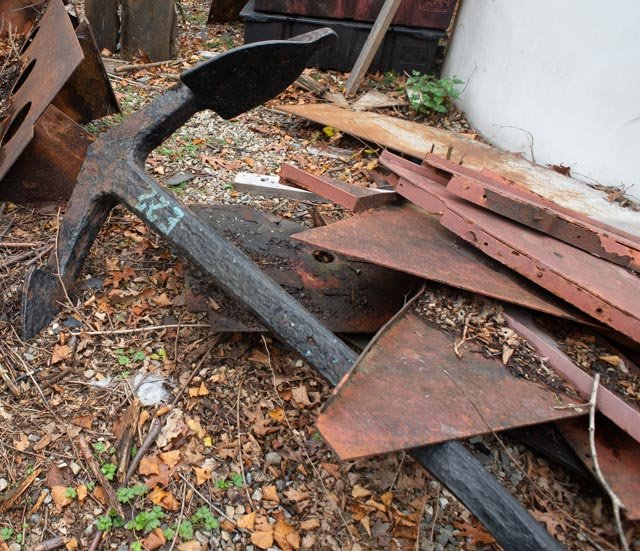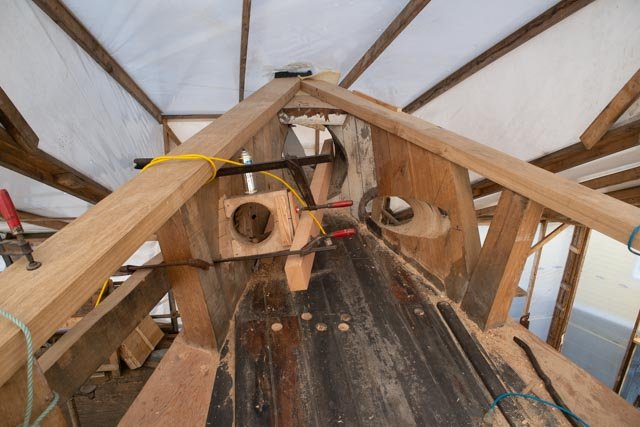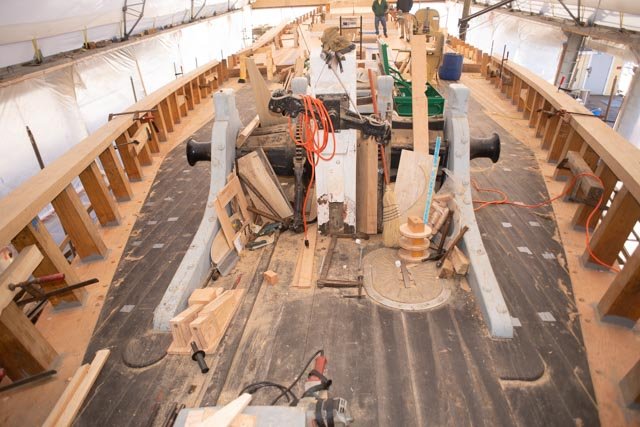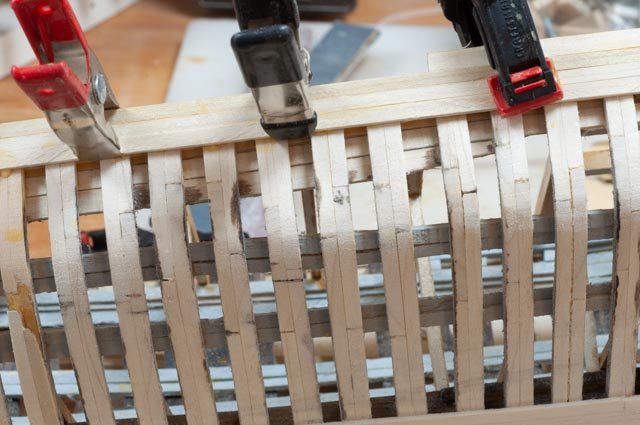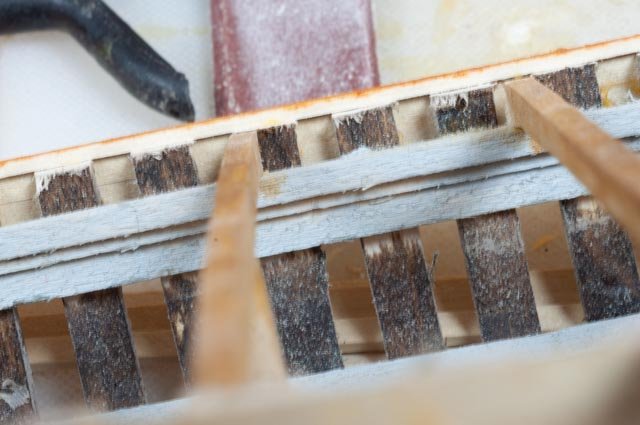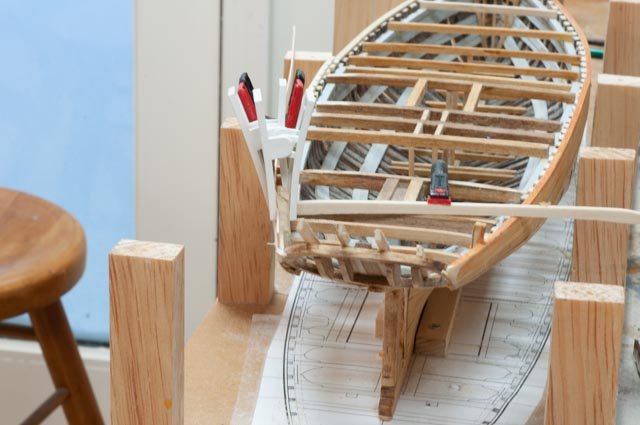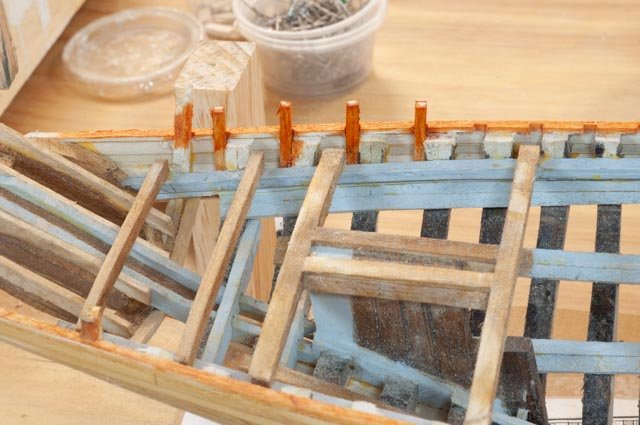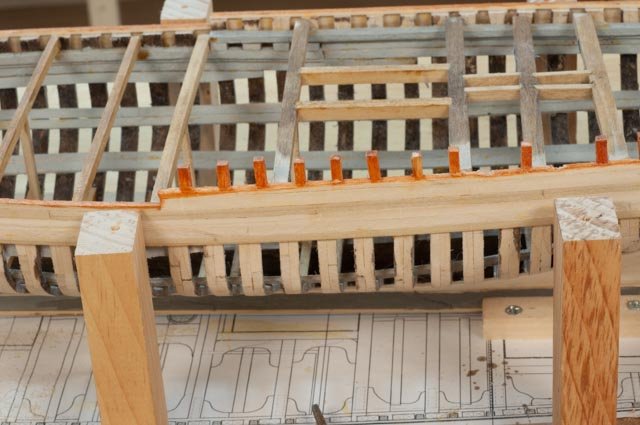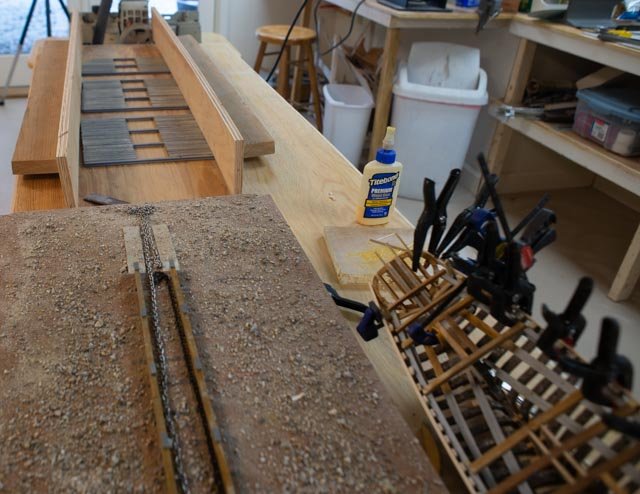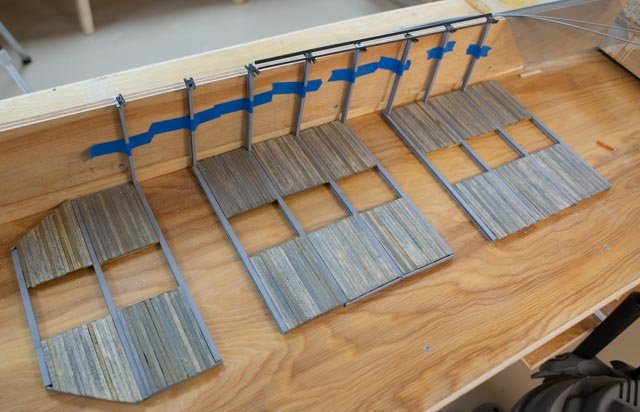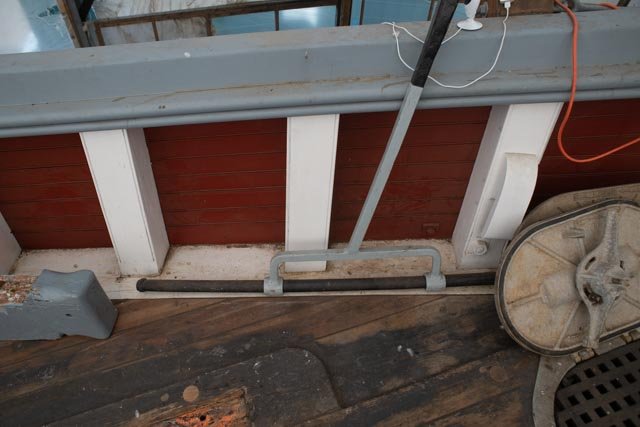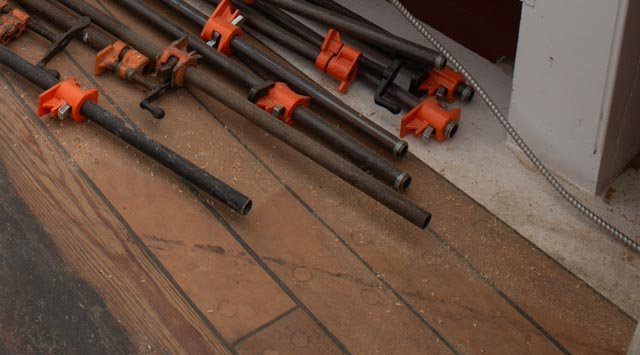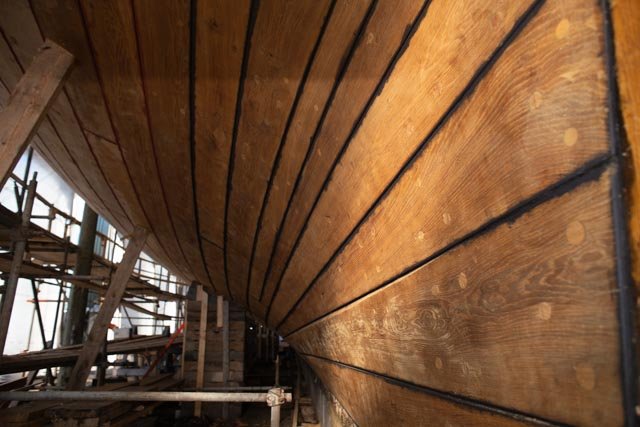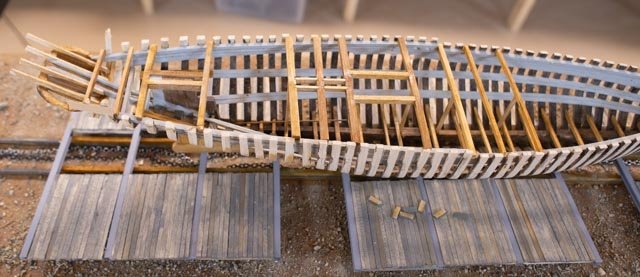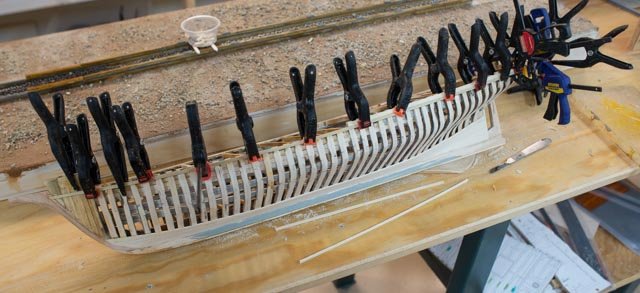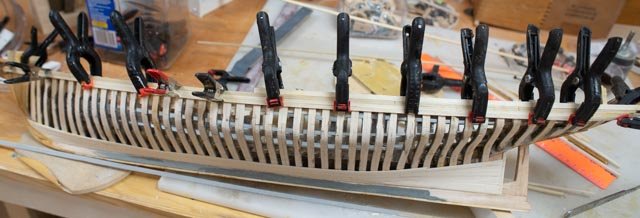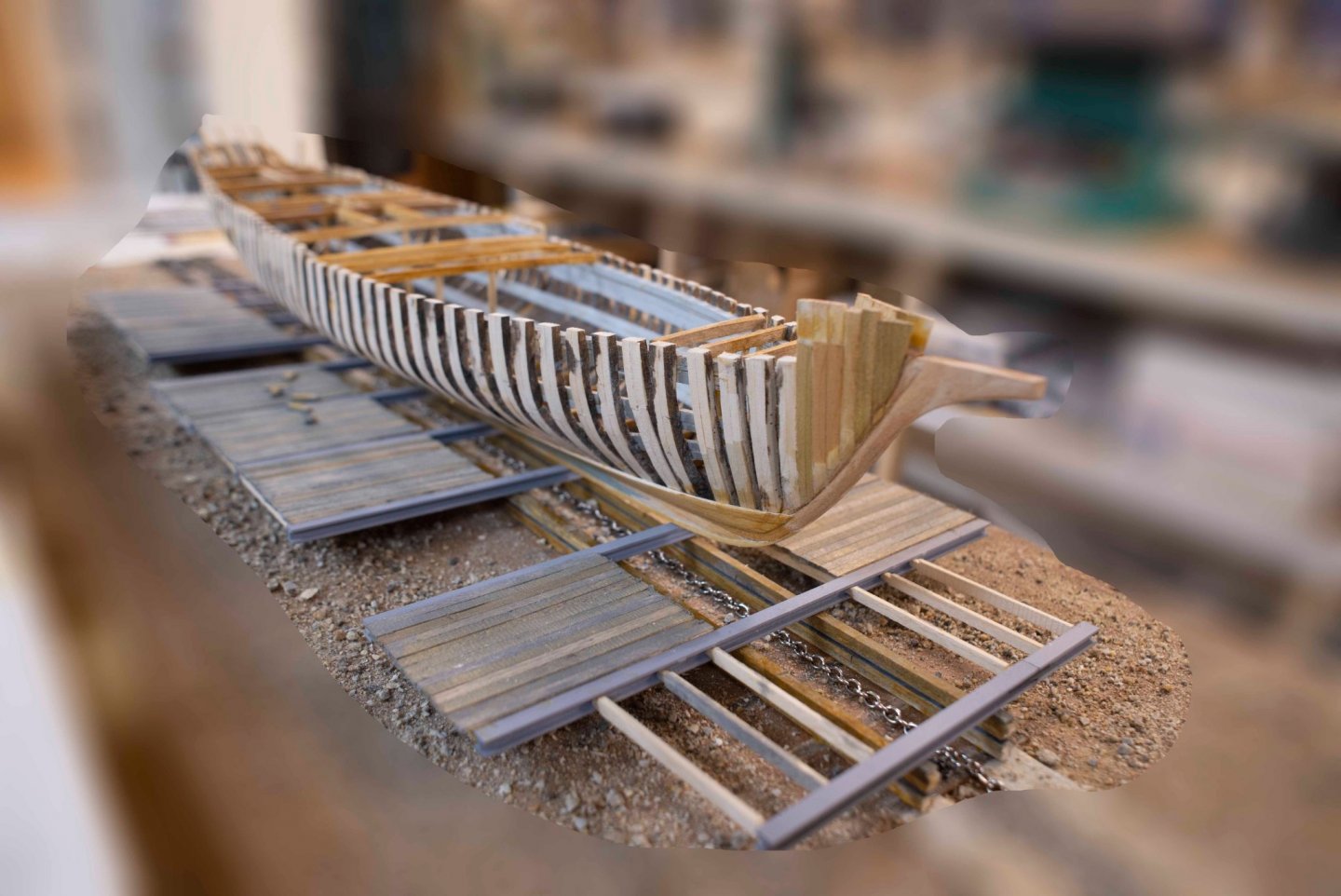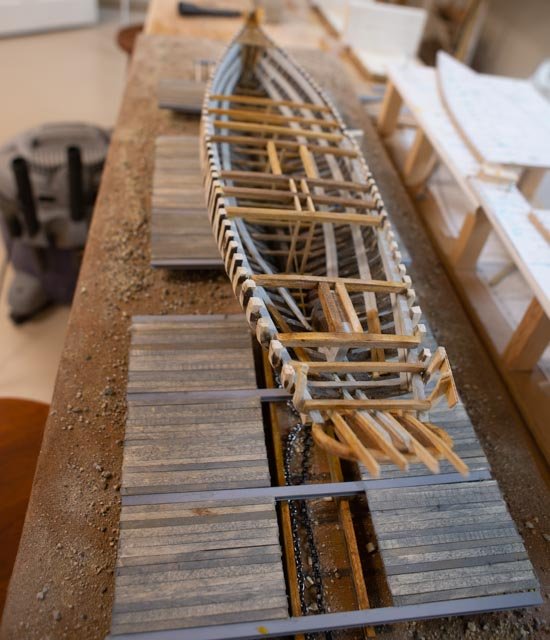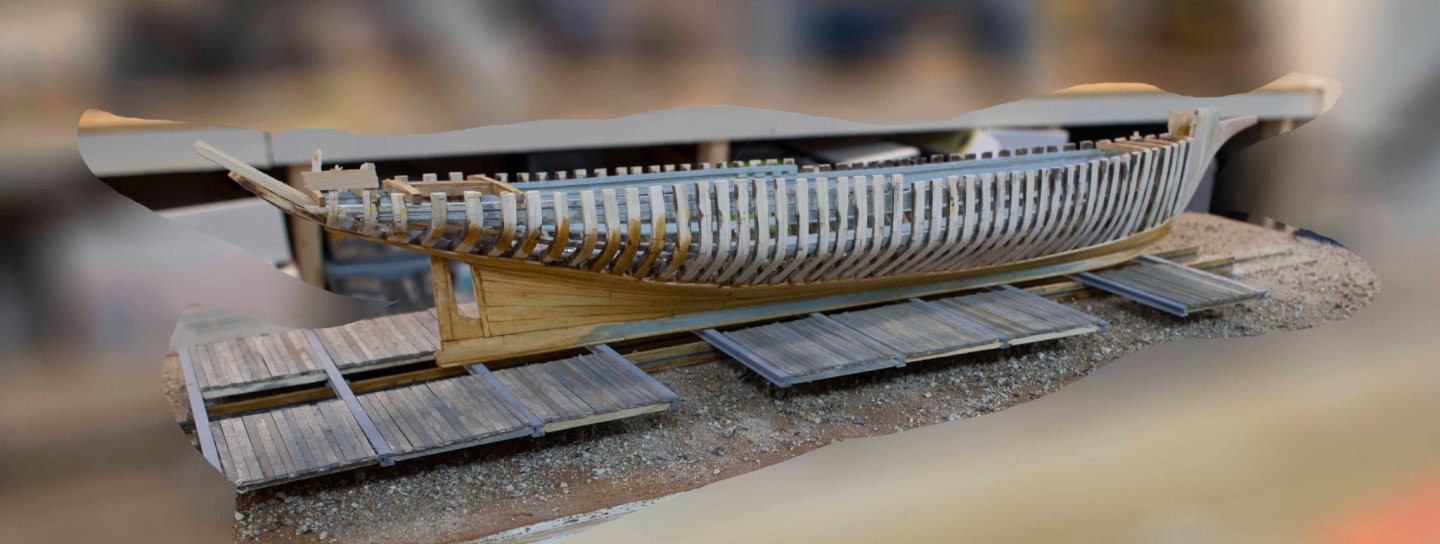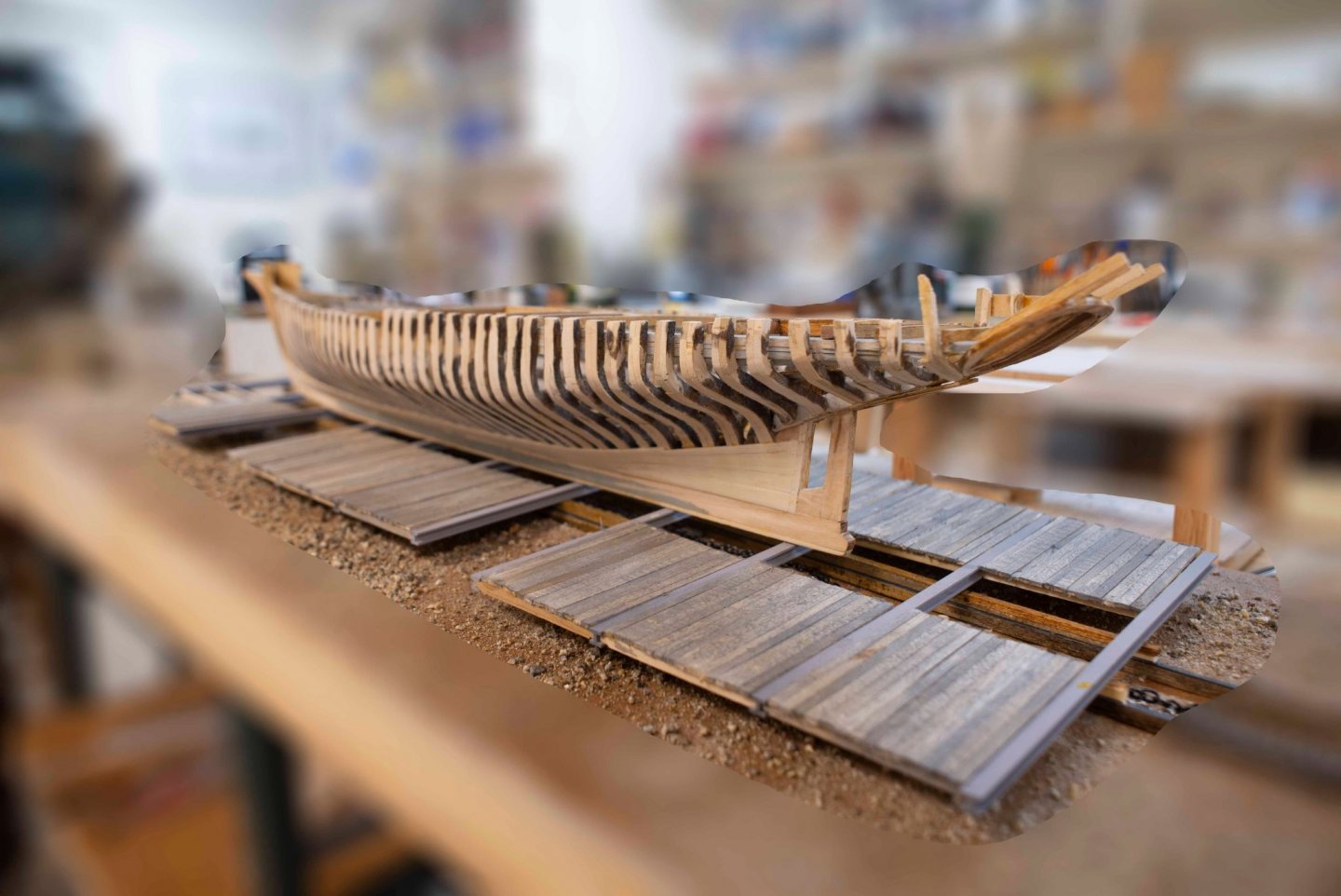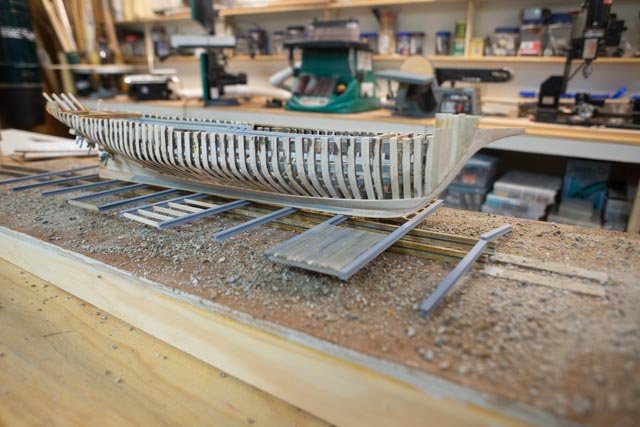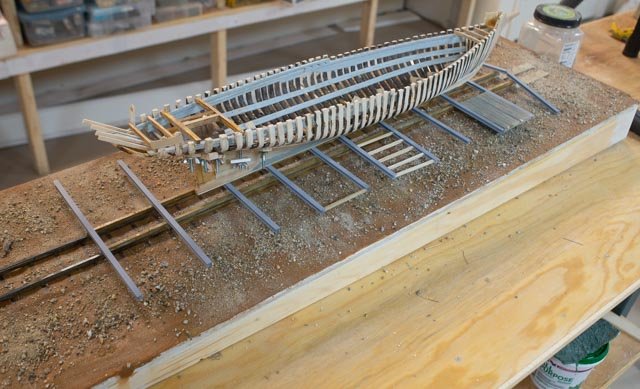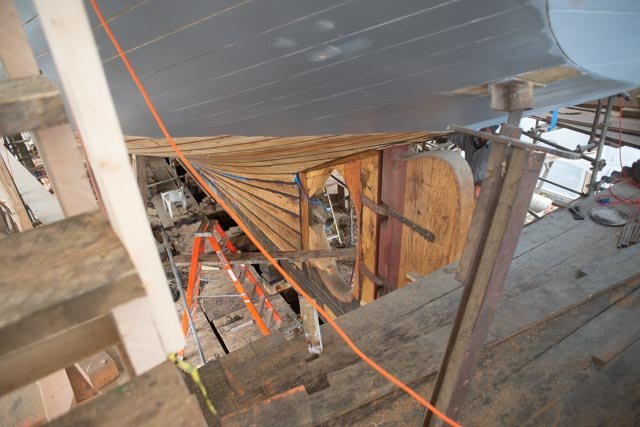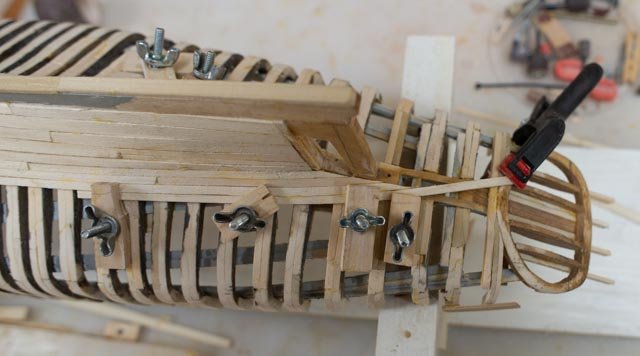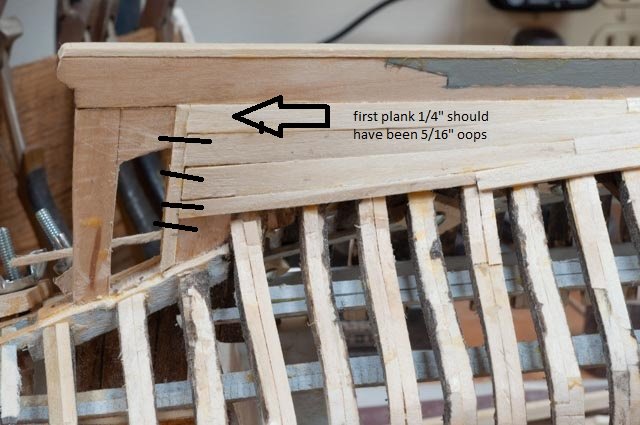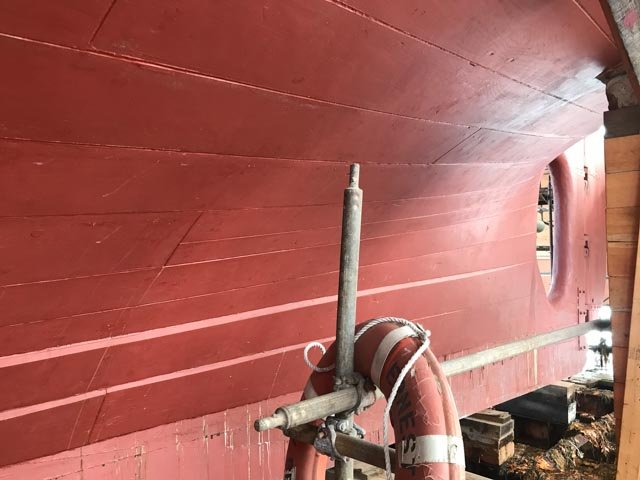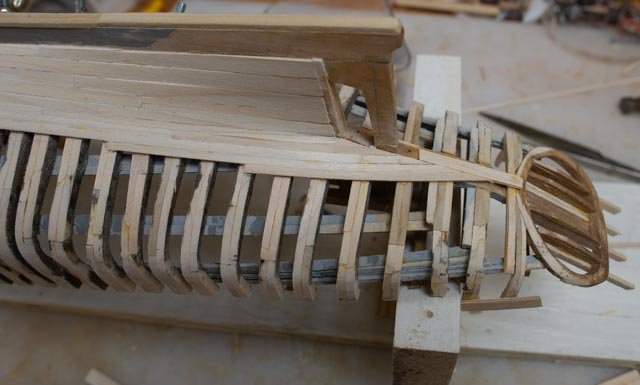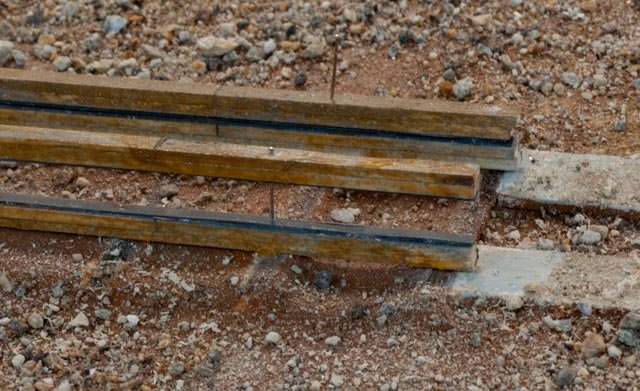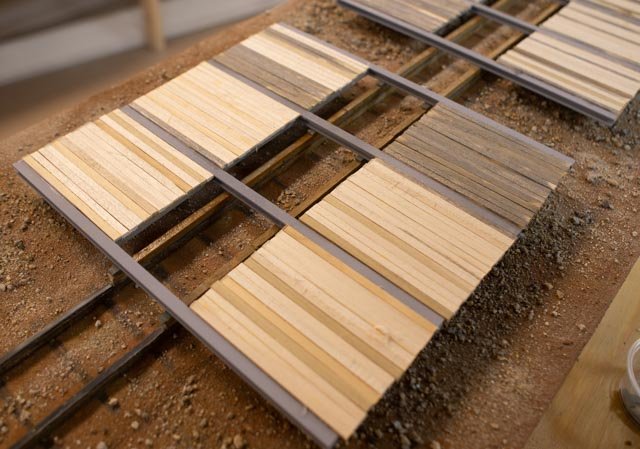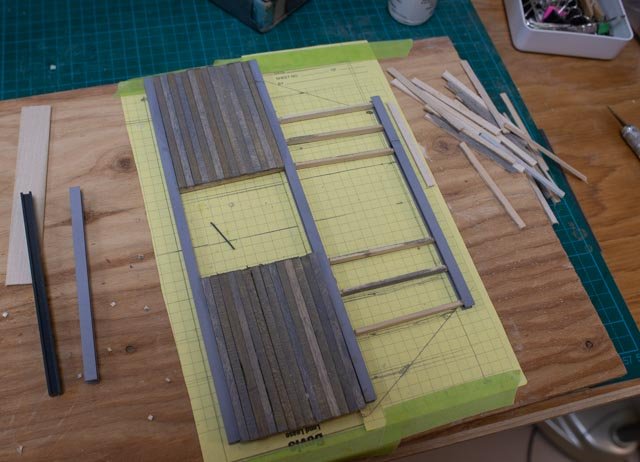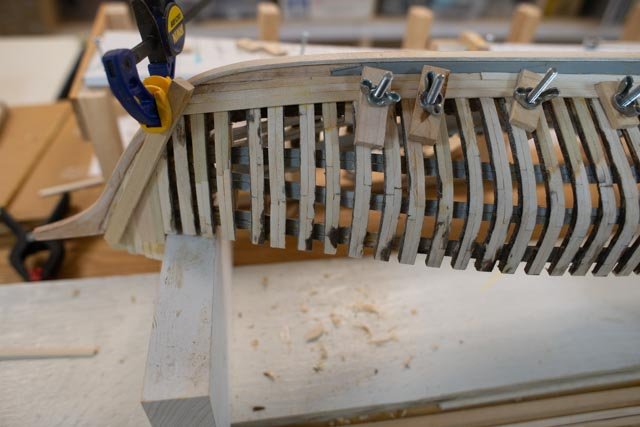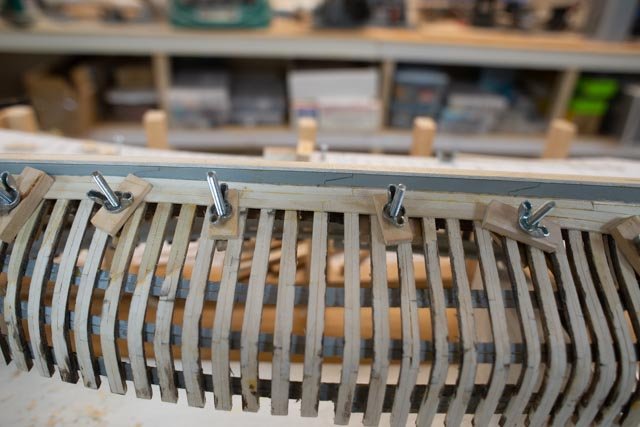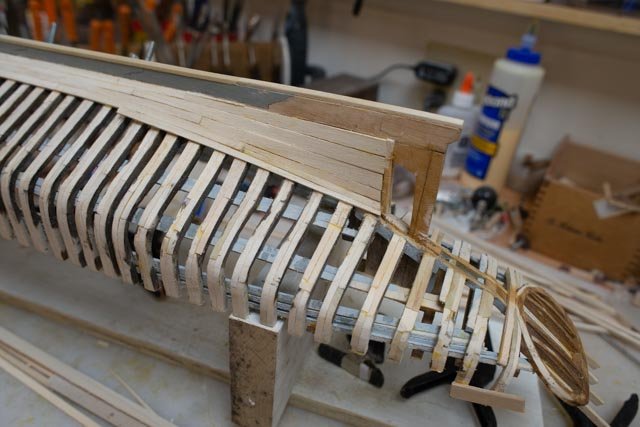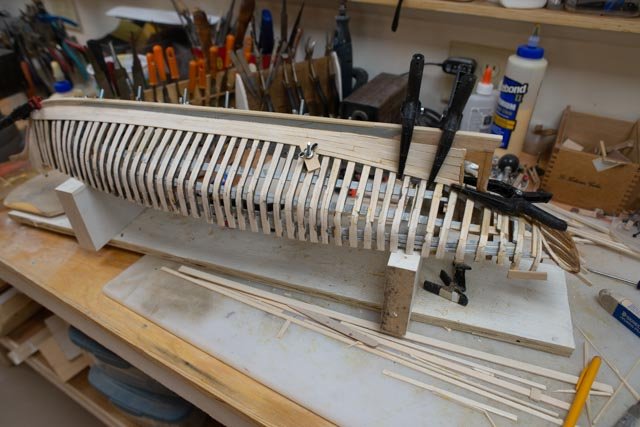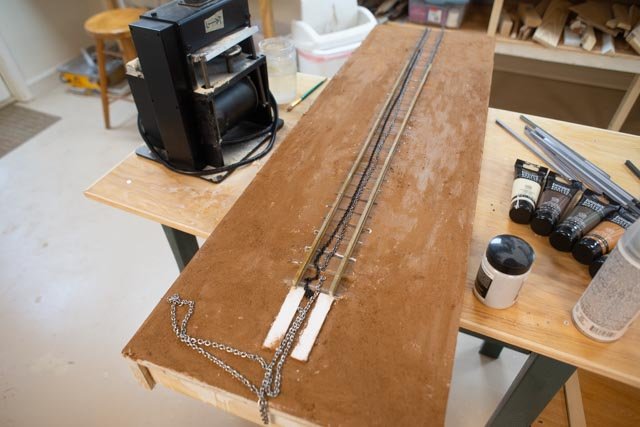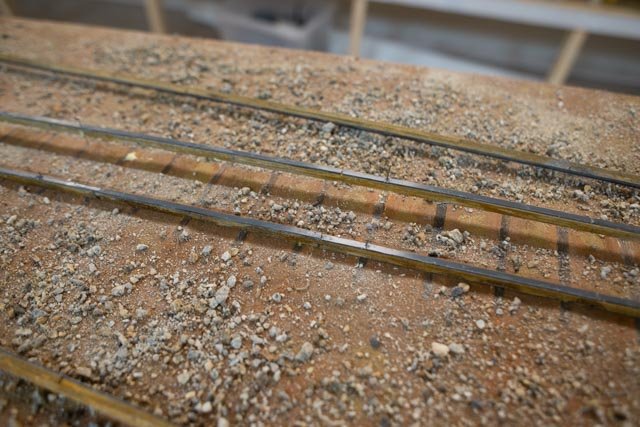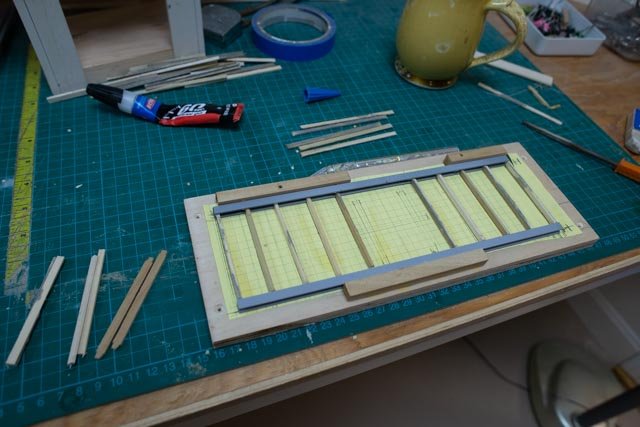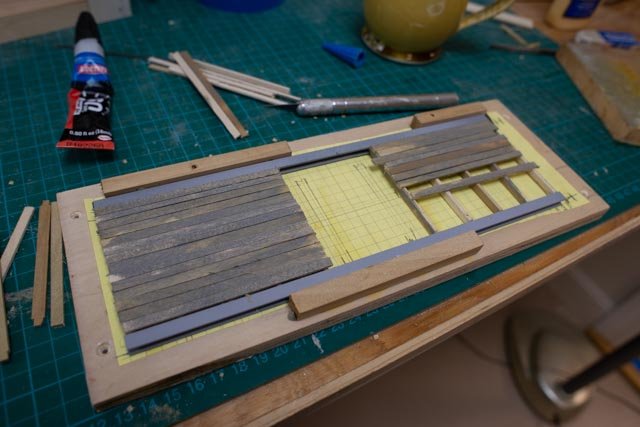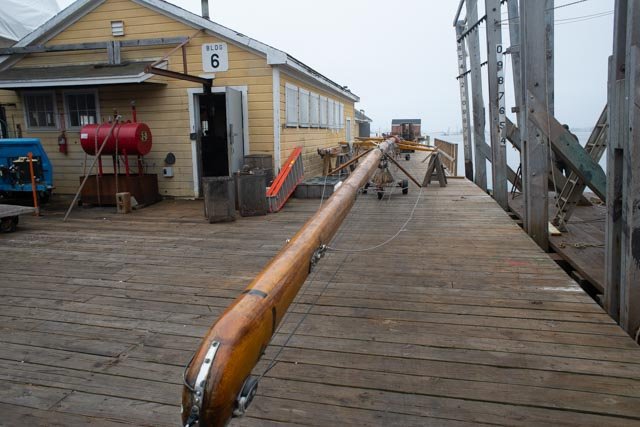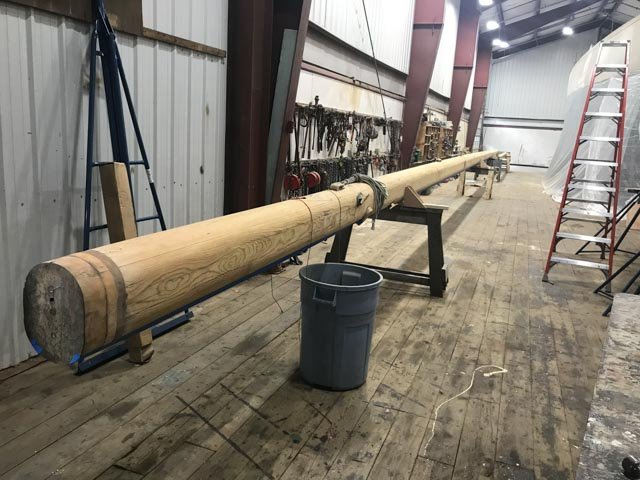-
Posts
860 -
Joined
-
Last visited
Content Type
Profiles
Forums
Gallery
Events
Everything posted by Jond
-
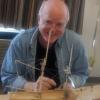
Ernestina Morrissey by Jond - FINISHED - 1:48
Jond replied to Jond's topic in - Build logs for subjects built 1851 - 1900
Post 26 Progress on top rails and deck level I am celebrating another small milestone this week. I completed the cap rails yippee. 262 Here we are gluing in the outer band of the monkey rail. I had some scrap 1/32” on the outside resting above the lower cap rail to maintain the right shape and recess…. The outer edge of the two rails match up. 263 here we are gluing in the inner band of the monkey rail. Two each 1/16” bands give us the 6 inch in scale rail. 264 looking better. Now to do the cap rail. It is narrower but more difficult as it rounds to the main cap rail. 265 here I took a piece of maple and started carving. it is a true trial and error approach for me. 266 here we are carved, and it is time to split it on the table saw for two pieces. 267 here is the port side from the outside. 268 here is the starboard side from inside Now what comes next and what needs more thought 269 in this view of the stern, I have placed a king plank. I plan to use maple for planking just to have some visual difference. Before I decide where to put decking, I need to build up curbs for the hatches, and things that interrupt the decking. I stared with the captain cabin and am now working my way around. I used a duller cherry stain only on the bulwarks again to show they are different wood. They are all Douglas fir as I understand it. So is the deck but it gets a very dark treatment eventually 270 here we see the bow section. I have drilled the hawse holes and set up for the bow sprit. There is a king plank sitting there but ai am unlikely to use. The old drawings show no king plank and the photos I have show none. I am just used to them. the phot of the new deck clearly shows the stern to have none. Also, two planks in the middle fit nicely against he Sampson post. Sounds like a tail wagging the dog but something will be done. if i mount the prop bowsprit no-one can tell anyway. 271 this shot was last Friday just laying out my supply of beams to see if I was ready to attack the main deck. I also had just installed the last few lower deck beams so that area is complete less construction planking and ladders. there is progress below on the dock as well. 272 this is todays celebration. Other than the steering gear rig, which is in fabrication, the after-deck framing is complete. I have cut out the curbs [ kerbs] for the next hatch and they are in for painting white like the captain’s cabin curb. The plan above shows I have used the 2006 measured drawings as the basis. The were no noticeable differences going through the current rebuild so we should be OK. Next up I will continue forward on the deck frame and building of the diorama dock cheers -
Allan I just found this posting, so I understand you email I will post photos on how down hauls are tied off on my Bluenose log. I am restarting that to complete sails and that will include gaff down hauls Main gaff has both p and s going to the rails Fore gaff drops straight down to starboard fife rail Cheers
-
This posting is to record the progress as I pick up this build and carry it to completion. When I left this work in august 2018 the model got to travel around on pillows in the back of a pickup to two showings. We since have gained an open yard trailer that lets her lay flat and go under cover if need be. She was moved in November 2020 to this new house and has patiently waited for her star to rise again. My Daughter came for Christmas as Covid-19 has truly limited mobility. She was here for a work week and play week. Can you imagine…go to the coast of Maine and work through your computer as if you are still somewhere else. Anyway, the point is we decided to start the process to complete three upper sails and to replace the main sail and jumbo. Their replacement needs were well documented earlier in this build log and the question was both motive and time. My daughter took on the job to take the old mainsail and replicate it. Then she added the in-scale bolt rope and helped in any other ways. I started to commit a few hours a week away from my other build to plug along. Today, I like many others have enjoyed getting into an exchange with other Schooner lovers about how certain lines are made off. As this build records, I made two trips to Lunenburg and took oodles of photos in high definition, so that I can blow them up and check many things out. So, I answered the specific question but choose to document here the findings as I too want to have those lines included on Bluenose. I recommend anyone reading this log to jump over to the build of the Effie Morrissey 1898 by Allanyed. In doing so, you will find a beautiful schooner being rigged for fishing at the same time. She fished from 1898 to 1925 mostly out of Canada with that rig which is contemporary with Bluenose Therefore, for the record, I resumed work Christmas week 2020 to complete sails and running rigging hopefully by summer. 1101 here she sits in her new home missing the old mainsail. If you look closely the main top mast is off too. While she sewed the new sail, I was in the shop making more hoops. 1102 here if one looks closely there are broken parts on the windless and probably missing pieces from the moves 1103 here we see the old jumbo. It is the only remaining sail. As for most of us, if we make one or two of something and then compare it a to the third and forth made a few years later, there is likely a need to rework or to replace the older version. We will see when we get to that sail. First to the others I had made up the three topsails in 2017 and pinned them to the model while on display as seen in photos above 1104 here the main topsail is in place. The tack lines and clewline are sewn in and coiled, ready for rigging after the mainsail is set 1105 here the hoops are sewn to the sail. I had to add three hoops to get the number right…a lot of extra trouble. I can’t remember how I missed that before I fixed that mast. 1106 yesterday I finished adding lines and hoisted the fore topsail. Next week the hoops get sewn. I am working Sundays on this project so it will take some time. also there is no running rigging or sails on my other current build, so this work is refreshing. I did some research on the gaff down hauls and will post that next time. I believe the clewlines act as the down haul for these two top sails. And the jibs are all in as well. That leaves the two gaffs to rig, so as I attach the top sail sheets, I will need to splice in the down hauls to the ends of the gaffs. All for now
-
Allan no sail plans yet for EM. One more detail I suspect is there were more connections in the stern. I again take my learning from Bowdoin arctic rigging and Bluenose with its large size. There were quarter tackles to secure the boom, the topmast backstays were made aft for the upwind side and last pin behind dory tackle on the main mast for leeward side. There were down hauls on the main gaff peak tied off to Starboard. Also several lines both on the rails and the fife rails needed snatch blocks on deck to allow a few men to grab the line and pull and then take it to a pin to tie it off. We learned that while sailing on Bluenose. I believe there is no need for all the travelers on Effie though. For sails like the fisherman's staysail, they were flown from the deck per tack. the tack lines and all add up to more pins. The halyard was continuous and that means two more pins and deck block. Main and fore halyards were continuous as well. I only made the pin rail according to the drawing. if i were going to fly sail I would add several pins. I would move flag halyards to the shrouds etc. like on a ship. i wish you the best in the challenge. I am grateful for the park service drawings but remind us all that they are measured drawings made after many tough years of packet service and ultimate return to US in sorry shape. I agree with you and other commenters above that Chappelle and other Gloucester/ Essex Schooner info is the best source. I typed this much because it is 18 degrees outside. cheers
- 86 replies
-
- schooner
- effie m morrisey
-
(and 1 more)
Tagged with:
-

Ernestina Morrissey by Jond - FINISHED - 1:48
Jond replied to Jond's topic in - Build logs for subjects built 1851 - 1900
thanks John Allan here is the buffer. I am very happy you are doing it. I am modeling pre paint, so I think home free without deck furniture. the railway is definitely adding more scope though. I went back up on deck to see if they have a horse. that would mean to my understanding that after back and forth to the buffer they come down to a horse to feed the port side bitt. I did not find one. To be fair to the yard, they are still waiting on the rigging design. new masts etc. also my visits need to be delayed a bit. cheers -
Allan i love your work...so clean and crisp. I am just catching up on this saga of pins and cleats on the boom. It may be a stretch, but I learned a lot when I researched Bluenose for my build. I went to Lunenburg twice, spoke with the captain, sailed on her etc. He pointed out things of difference on Canadian schooners, but they did not include this subject. There is a great resource I bought while there, The measured drawings on Bluenose LL by L B Jensen. He had taken, as I understand, information from the original 1921 as a basis. Also, there are numerous photos of the original online that I used. The Captain told me running rigging has not changed other than material upgrades. The book of drawings clarify as follows: Pins in the yoke of the main boom clearer take both the Boom Tackle [ guy] on the starboard side and topping lift on the port side. As to the ring forward and below the boom….if I understand correctly....The yoke rides on what I unknowingly call a table or boom seat. Below the table are two bands with forward attachment of a small winch. I assume [ guessing] it was for using the halyard whips to snug up sails. The new Bluenose II , which is actually Bluenose III as like Ernestina she was completely rebuilt again about 10 years ago, has nothing below the “table…boom seat”. Another possibility was to place a snatch block there instead of on the deck for taking halyards or whips. We need to remember there is, nor ever was, a motorized winch to raise those heavy sails. Flag halyards on the Bluenose drawings are pinned to the forward most end of the port and starboard pin rails. One on either side [ two more needed pins.] One of my concerns looking at the Ernestina park service drawings is the lack of pins on the rails. There are more lines than pins for complete running rigging, dory tackle etc. and no place to put them. Good luck . jon
- 86 replies
-
- schooner
- effie m morrisey
-
(and 1 more)
Tagged with:
-

Ernestina Morrissey by Jond - FINISHED - 1:48
Jond replied to Jond's topic in - Build logs for subjects built 1851 - 1900
Post 25 How to finish the outside Now the cap rail is going on, I need to figure out the final finish for the exterior planking vs. frames etc. First up, let’s get that cap rail done. 251 I continue to use milled poplar for this build. The rail is marked and cut out of ¾ inch strips 252 The mid-section includes the pin rail for the main mast. 253 here all rail sections are on and ready for shaping. I used this process also to build out the fan tail. 254 at this point, I feel we are starting to look like a schooner. The rail makes so much difference. Now how to finish, and what to show 255 here I tested an attempt to drill and plug holes for trunnions on the left column. No good and too big and way too much work for the result. The second frame to the right is simple, smaller holes drilled and rubbed over with stain to fill the holes. Some sawdust was included. This is the way for me and now let’s get it on. 256 on this attempt of the lower planks, I tried applying shellac to better fill up the holes. 257 in this view I only used the golden stain and I like the results more. It is a subtle indication of trunnels. I was lucky to have earlier images, previously posted, showing the pattern. 258 here I have drilled, resanded and restrained the starboard side. This view from aft also shows the transom upper half now planked as well. 259 this view from the bow. Note I have fit a bowsprit to help complete the bow. 260a here in 2 stacked photos, the whole set up is clearer. One can also see progress on the port side steel structure for the railway. 260 b Next up more railway progress Cheers -

Ernestina Morrissey by Jond - FINISHED - 1:48
Jond replied to Jond's topic in - Build logs for subjects built 1851 - 1900
Post 24 Steel work coming along and a need to plan docks. Every day that I can work on this project I have been adding more and more inside. I believe in another week or so I can stop. In the meantime, I need to finish the basic hull construction, so that I can finalize the finishing process. The railway could either stay simple or become a real rabbit hole. I am going through the process and will share my thought process. The hull 241 this shot is intended to give a progress view of what the innards will look like. I have a dozen or so more lower deck beams to install and then decide what to do about its decking. After that phase I will complete the main deck beams. 242 this photo shows the build out of the lower deck. The deck beams are often removable, and all of the panels of marine plywood can come up. Here we see a waste tank. There is still 60,000 pounds of lead ballast to be placed, and access to below decks will be continuous. There will be fir decking over these panels at the very end of the construction. In some earlier photos we saw plywood laid out for working platforms during the construction. What I will try is to place a few sheets to reflect that purpose and temporary construction planking to support a few construction ladders. 243 I have laid out the first cap rail and will be fitting it next, as soon as all the waterways are in. I have started with the transom area and that also shows in the following photos. I hope to clean that up for next time. The diorama Lots of progress this week. The first stage was humorous. 244 I upgraded my blackening equipment this year to include the little slow cooker for better temperature while pickling. I then went to Michaels and Joann’s and bought several sizes of chain. What I found was a mystery material from china. I tried it even though it was magnetic, and to no surprise it did not work. I did get some form of coating off because after the whole process including the blackening process it was quite bright. Off to the garage we went for spray paint with auto primer. That worked nicely and then I am using a combination of artist acrylic to simulate the variety of colors. Rust, slime seaweed paint spills etc. 245 also off to the garage to spray out the ABS steel frame. I am happy with it, but I ran out and the next can is a different shade of gray…….oops 246 here we see ABS gray steel, painted chain and the beginnings of simulated concrete. Next up is the blocking. 247 here is the most complicated one. It will surely go in last. Overview 248 here we are sitting on new blocking with the second side [ north] steel frame being assembled. I added to the photo where I need to decide if I am going to build the dock, I think I will at this point 249 here we are looking from the west end. The transom is coming along. It is clearly the most difficult part. The chain and track and soil at this end will need more painting and seaweed. Again, I show the dock that I plan to try to do. 250 this drawing shows my figuring out how to make the slopes work to fit the dock to the railway properly. I have several photos and believe I can get it right. I must slope the existing diorama about 5/8” one end, so the red slope fits a level dock. All for now -

Ernestina Morrissey by Jond - FINISHED - 1:48
Jond replied to Jond's topic in - Build logs for subjects built 1851 - 1900
thanks John always a pleasure for peoples encouraging comments. Suggestions are always welcome too! cheers -

Ernestina Morrissey by Jond - FINISHED - 1:48
Jond replied to Jond's topic in - Build logs for subjects built 1851 - 1900
Post 23 Sometimes we get ahead of ourselves. I was able to get to the yard last week as it was not a workday. I went through many things and learned a lot more. It should not be surprising that not having been there for a while I got ahead of myself on a few details. Oops we say that is why they invented saws and chisels What I missed of note is that there is a step in the lower deck directly under the main deck step. fortunately it is too slight to really notice so i shall just declare it to be an oops. I also mis labeled an earlier photo of tanks [ I just edited it in the last post] and now I will fix the tanks. I also learned there are three materials, stainless, fiberglass which has a green tint and a white painted different plastic for gray water. I will now go through and make a few changes. I will also declare that I will not have all the tanks in exactly the right place as i do not have drawings, only my memory. There are many of them and even today they are not all there yet. I saw more about what was completed in the Cape Verde rebuild of the 1980’s. I will make the pieces, as I learn about them, stand out somehow. Typically is means dark stain on wood and already painted on painted parts. A little Progress as I got diverted back to my old Bluenose schooner sails that were never completed. i will post that when done on that log some time in the spring . 231 here we see below the old Cape Verde 1980 rebuilt Sampson post 232 Here on deck we see both the Sampson post and the windlass is to be refurbished and saved 233 underside view of mast partners show 6 inch thick and Douglas fir 234 for this stage I have painted the top white and stained the lower section walnut to identify this as being salvaged. 235 here I am starting the inside half of the waterway 236 I lay down a section and mark the stanchions and then cut and file the notch off the boat. The combined width reflects 12 inches. It is not enough for all the “sawtooth” projections to receive the planks. More on that subject later 237 here we see that the lower bow stem piece also survives from the 1980-85 Cape Verde rebuild. It was quite dark at this stage reflecting its age. 287 I have stained this section to reflect the old wood. 239 here is the aft bitts that are staying with us also from Cape Verde 240 here I have stained the bitts dark to standout as Cape Verde components. they came out too dark so more on that to come. Now that the waterways are in place, I am better able to dress up the deck beams to fair them out. They will all get sanded and restrained soon. In this view I am starting the aft rail. I want to get this main cap rail on, complete the waterways and then think about what decking I might do as I deal with the un trimmed [ nibbed] waterway There is a lot more inside that i have gotten done. it is hard to photo. I need to figure out how far to go. I am thinking to leave out most of the lower decking to allow views of the inside frames, but will need to do something. Maybe next time. Also, the missing ABS just came in. I will get back into the railway too. All for now -
Alan This log has been a great adventure for many of us amateur schooner buffs as well as the experts who added much. I was at the yard today and saw your model in the flesh. it is a joy to see. Here she lays for now anyway Eric, the yard director, was happy to come over and take off the cabin roof for me to see inside. great work and lots learned by reading you log cheers jon
-

Ernestina Morrissey by Jond - FINISHED - 1:48
Jond replied to Jond's topic in - Build logs for subjects built 1851 - 1900
Alan I was able to go today as the work was off for Friday. it was 22 degrees and a little icey but I got some great information. I will be including some of it in the next post as I found a few things i was doing wrong and few more differences in this new design. I also saw you model and will post the photo in your log cheers -

Ernestina Morrissey by Jond - FINISHED - 1:48
Jond replied to Jond's topic in - Build logs for subjects built 1851 - 1900
Post 22 Continued work below deck The next few posts will include elements where I take some information from the real schooner and attempt to represent that image in the model. As I am always learning, some try’s will work out and some will leave opportunity for future learning.... First, where are we at the beginning of 2021? We have about four months left till show time, so pressure will begin to build. Beginning of 2021. We are still in the covid bubble. 219 here we see bulwarks recently added on the port side and stanchions going in to starboard. The white styrene handrails on the steel structure are on hold waiting for more ABS material that needs to go in first. 220 looking down we see the new lower deck framing started. Laugh at me as it is all 3x 9 inch joists. [ oops for later] 221 looking forward we see some main deck added elements like the windless supports, mast partners and a few more beams 222 Here is our year beginning stacked, blurred, cropped etc. photo. Unfortunately I was not aware our crew member was napping on the job. Below deck study. I have collected here a group of photos from which I am basing the work below deck. Little of this detail would be here before all planking and decking were in place. 223 here is an image into the captains cabin showing two tanks below the lower deck. I also like the construction ladder. This area is a bunk room for added adventurers 224 here we see the engine room under way before arrival of the engine 225 here is an underdeck tank in the engine room. 226a here is a detail that is a ‘bridge too far for’ me at least. Note that some of the deck beams are perhaps 2 or 3 inches thinner than the others and have shims. The nominal beams from the 2006 drawings are 9 inches and all of mine represent that dimension. Also tucked behind on top of the shelf is a 6-inch-deep fore and aft beam that must beef up the edge of the water way where planks end in between beams. This area is open and allows circulation of air to keep out the moisture from condensation that would cause rot. 226b here on deck we see where the fasteners go though along the edge of the waterway. I went below to figure out what they attached to and figured out the beam. Fortunately, the model does not need them. 227 here we are in the galley looking forward, and can see my oops. I need to change the framing. It is clearly 3 by 6 [ I first installed 3 by 9 ] That correction will help where I am squeezing in a tank underneath. I also need to prepare any readers that the clean sharpness in the forms of the framing due to the workmanship of the real thing are not carried through in my work....sorry 227b I added this photo where we can see the design. The area between the stringers will be filled in with perforated bead board. The air flow then is continuous to keep things dry. The bulkheads are all insulated and sealed off. to the left side of this photo is the captains cabin, and to the right side is the hold. 227c I add this photo as it shows the completed assembly. This is in the foc’sle. Note the holes in the bead board filler panels Model progress I see in my attempt to document this work I need to find a way to photograph inside. Then I could show each section and make it part of the story board. On the other hand, my workmanship is better viewed from away. 228 Looking though the deck frame we can see I added a shaft and engine mounts. The framing will make the engine location clear. 229 here is the little tank. 230 Here is the start on other tanks in the hold area. I will not get all the right tanks in the right places but will try to represent the design in this build to have them there. Example, I doubt there was complete holding tanks that new work will require. the old design had water tanks above the lower deck. Looking forward Model I need to get more of the insides completed so I can decide if I plan to add any more planking. I then need to consider how to finish the planking. Ditto for any decking. I am thinking that below deck I may have some started but the look through is I believe important. Diorama I look for missing ABS structural shapes that will let me get past the building of the frame on the car and then set the model on the car to begin adding the movable stands. I have chain now and need to get it blackened and set. There is also a dock to build on the port side. I have worked out the angles etc. and will get into that soon. All for now -

Ernestina Morrissey by Jond - FINISHED - 1:48
Jond replied to Jond's topic in - Build logs for subjects built 1851 - 1900
Rich good to hear from you. I still have my two whalers started from a few years back when you were my source for tips on the Kate Cory They are still on hold. They will become brigs built in Boothbay eventually using matched sizes from the Kate Cory hulls cheers . -

Ernestina Morrissey by Jond - FINISHED - 1:48
Jond replied to Jond's topic in - Build logs for subjects built 1851 - 1900
post 21 I solved my plan for ABS structure and started interior work on the hull. Christmas week always knocks us off schedule. This year was no different. After the last posting, I decided to build the car in place and make it secure. I will then somehow get the ABS structure built and set-in place once.{ I hope] So, for the holiday pictures we made a little progress 209 here we see the combined project. The car is now pinned in place and the final sections are being planked. 210 here is a fun view of the hull with the crew. 211 here is one of my presents to myself. I took the time over Christmas to master the art of stacking photos so I can get the whole schooner in focus Now to work on the ABS steel structure. I have now made three orders to Plastruct and I probably will need a fourth. I started over sizing members and now think I have the right combination. I also figured out how to connect pieces. It is just like soldering…..so 212 here I have taken over the soldering bay to preassemble the little pieces of plastic. 213 they have to be held together and then solvent glue applied to “weld” them together. 214 up in the air can be an experiment in clamps. 215 here I have rearranged the jig. It is laid back at 5 degrees for the cant. 216 here is my solution to the problem. The ¾ strip is held by through bolts to be snug to hold things in place. I plan to build out the side assemble and then take it to the garage for spray paint. More later The hull 217 Here in a stacked photo, we actually can see some progress on the interior hull work. This shot shows what I meant earlier when I clarified I will try to do enough of the framing to better explain the make up of the schooner and not stick to a more authentic sequence or better said snapshot. At a time, when a lot of planking is still not installed, the bulked framing in this photo would not have been in place. 218 in this photo, the Sampson post is in and I am aligning the deck beams that will get inserted supports for the windless. I am working both the lower deck and the top deck at the same time. I found if I run through the lower deck, when I drop in a post, it does not always hit the lower beams just right, and I may need to remove and adjust. Anyway, I am making this part up as I go. On the far side of the photo the bulwarks are in place on the port side. All for today -
Allan I thought you might like a photo of the recently abandoned Ernestina anchor. According to Ross, they had one of each when they showed up a few years back. A wood "banks" stock [ in photo below] and loose metal "club" stock. They will apparently be building new anchors and he is not yet sure what design. I am sure like Bluenose II it will be more about the coast guard than history. enjoy your holiday jon
- 86 replies
-
- schooner
- effie m morrisey
-
(and 1 more)
Tagged with:
-

Ernestina Morrissey by Jond - FINISHED - 1:48
Jond replied to Jond's topic in - Build logs for subjects built 1851 - 1900
Post 20 Waterway and stanchions and railway car platform planning I find as I sit here to gather my thoughts and maintain some workflow that I am suddenly working on many different things at once. Some of what I am doing is jumping ahead to be sure that I do not get two blocked by sequence. Example, I had left out one top whaler on the starboard side thinking I wanted a better view through the frames. I now realize that was silly, so I luckily was still able to get it in and use the little clamps to hold it during glue up. I am also not sure if I want to add more planking. One side is more done than the other, I may revisit that one too but I need to decide before adding the inside lower deck and remaining deck beams. To this week’s progress. Hull work I feel it is important to complete the waterways and establish all those lines next. Seeing that in this design the stanchions are not part of the extended frames but added members, I thought about different approaches. In pictures of the real waterways, one may be amazed at the workmanship. The waterways were mortise cut and then set down over the stanchions. Wow, I am not that good. My solution is to install the waterway in parts. First the outer section is a 1/8 plank that I can bend to the curve easily. I then use a small square file for each stanchion. First let’s look at the real thing 199 the bow. Wow how to get this look or even close. All the wood here is Douglas fir except the tops of the knightheads. They are the Danish Oak. The fir deck is oiled. 200 The waterway is 15 inches in the thin areas. I notice a slight reddish to the fir in this light. [ I will try to replicate a slight difference]. Can you imaging the care to mortice the square holes for the stanchions! Here also we see the cap rails. They have mortises with roughly 4”x4” tenons and the are bent to fit as they are three inches thick. Again I say wow 201 this view is to indicate the widening of the waterway for the ends of each plank. That means wider than 15 inches. That means I need to either bend a piece greater than 3/16” or make the inside in two more pieces. We’ll see what happens. 202 here I am gluing on the outer peace of the waterway 203 here we see looking across to the starboard side the outer piece of the waterway. Looking down one sees only one of two gray clamps installed. I had thought earlier to leave this off for better views but have decided to install it. 204 here I am gluing in the first stanchions 205 in this view the waterway and the stanchions are in and stained with gunstock to show the redder color than the golden hue of the oiled oak. I think it is too much difference and will not try to tone it down. 206 here is the outside view. The missing clamp on the far side is also seen here as I installed it this week as well Diorama More planning than physical progress. I need to figure out how to build the railway platforms that are canted out as about 5 degrees. I also have several items to preassemble. 207 here I have ripped some 5/4 stock at 5 degrees and then screwed on a scrap piece of plywood to form a potential backboard 208 here I am starting to assemble the columns. I have placed them where they will go to start thinking about how to make the platform. The results were to write up another order for more ABS model steel angles to better make the upper platform. Up next is a need to figure out a plan to use the ABS members to construct the railway car platforms, so that if the process does not work out, I will still have time to think of alternative means and methods. Also do I build the car off the diorama and then take it in for placement, or do i build everything in place? stay tuned. jon Cheers -
Ernestina and old schooner lovers... I went back through some photos on the deck. This post will not totally resolve the questions, but it does shed some light. in this photo one orients himself as to the decking coming onto the waterway In this blow up one can see pegs over fasteners . Also note the linseed oil compound that blackens the whole deck. In this photo we see similar plugs following a pattern that is obviously a deck beam. the Douglas fir decking and plugs make it difficult to see in an unfinished condition and totally unlikely to see in an oiled condition. From my reading it is likely that the plugs are cut from the same material that make them act the same, as to expansion, and seem to disappear. Wood trunnels on the other hand would be hackmatack or other harder material than the planking and thus stand out in hull planking. This may not be a complete answer and I will look forward to reading here the yard's answer. cheers jon
-
Please see photo from a few years ago of Ernestina planking. Trunnels are used throughout . as a plank crosses a frame, see the diagonal pattern. One up in one half of frame and the other down in the other half. Frames are pairs of 6 ", and spaced roughly 2 feet on center. The pattern alternates working up the frame as seen in photo. Jon.
-

Ernestina Morrissey by Jond - FINISHED - 1:48
Jond replied to Jond's topic in - Build logs for subjects built 1851 - 1900
Post 19 Start deck framing and a fun look at imaging This is a fun posting as we are a mid-point and need to start thinking about the overall look of what we hope to attain. Practically we need to get ready of upper planking as well. We need to set enough deck beams to set the elevation of the waterway. Figure out how we go forward with the stanchions etc. 192 All the bottom level cross beams are in. and the main deck beams are going in. I need to leave enough access to build out the lower deck frame too. 193 here the top plank is in glue up 194 here we have the first four top planks in place. Just before the planking above I took some fun views. I use these to start thinking about what activities I might want to show. Do I want four men adding a plank, three men on deck, swinging a load on the crane? 195 maybe the next plank going on here? 196 how much decking to have in place. Maybe the crane swinging a load of deck planks? 197 how much of the upper planking goes on. Do I want to cut out to see inside? What lays on the railway car? 198 do I install the rudder, have it laying there ready to go in? Part of the review is whether to do what I am doing or not. Currently my thoughts are to try to show a little of everything and be less accurate on the what the chronological sequence that might have shown. They would not have the interior bulkhead framing installed early but it sure helps explain how the schooner is divided up inside. I also have to be careful about scaffolding that will block views. Lots to think about Cheers Jon -

Ernestina Morrissey by Jond - FINISHED - 1:48
Jond replied to Jond's topic in - Build logs for subjects built 1851 - 1900
Allan further update from the yard. some good news and some oops on me first of all to the thicker planks the two garboard planks are 5 inch thick and 4 inch thick respectively. all other are 3 inched thick. the two thicker planks were designed in to offset the added stress in the keel due to the 60,000 # of lead ballast. to shave them down would reduce their cross section. From my late 1960 classes on structures, that suits me fine as the explanation. The fact that my shadow line shown in the photo was due to a reverse offsets, and the second side fit better, i have sanded it off. The model will look normal with all planks smooth. oops on me. I could have used thicker planks if i went through this before the fact. I am only a hobbyist, so artistic license is all mine Other info I got was not so good news. In reviewing the materials added to frame causing their colors, I learned the following. In the rebuild all frames below the waterline were treated with added tar. That did not come to me in the earlier discussions last summer. The linseed oil I was told then went on all frames. I combined that info with my experience from other such treated small boats, if exposed to sunlight linseed oil finishes go black. The outcome is the frames above the waterline would not all be as dark as I made them using the walnut stain. I am not darkening the outsides as they were planed and adjusted right up to the setting of the planks. tar or oil was applied just before the plank was set. The use of stealers they advised is normal where they have an inside curve typical near the rudder post. This approach somehow reduces the carving he said. With all the computer modeling these days I assume that was all figured out well in advance. Another bit of trivia i learned two years ago watching the Bowdoin planking was that the steam time for planks in the box before setting is one hour per inch thick. Thus those garboard planks would have been steamed for 5 hours. cheers -

Ernestina Morrissey by Jond - FINISHED - 1:48
Jond replied to Jond's topic in - Build logs for subjects built 1851 - 1900
Allan and Roger thanks for jumping in. I hope to get the yard's answers by the end of the week. in the mean time as to Rogers comments. from the biography of the Schooner; in 1898 she was done the way Essex builders would have done. She had no special reinforcing and no engine. In 1926 using George Putnam's money, new owner Bob Bartlett made two big changes. He had the frame redone and added an engine as well as changed the fish hold to a messroom with several bunks. He then had 1.5 inch green heart wood cladding. The photos of the 1921 Bowdoin show how this was done for the same purpose. If one wants to model Effie for 1926-1948 that could be added. That cladding on Bowdoin did not go all the way down to keel though, it stopped a foot or so below the waterline. as a foot note, my 1924 model/diorama of Bowdoin is missing the cladding...oops jon -

Ernestina Morrissey by Jond - FINISHED - 1:48
Jond replied to Jond's topic in - Build logs for subjects built 1851 - 1900
Post 18 Bottom planking continued, more on the railway and steel delivery This past week the shipyard was interrupted to put down some new flooring. I guess COVID-19 is a stimulant for home improvement. At least the room involved is planned for the model gallery. We’ll see if I get to use it. Some progress was made as well as a need to make a few decisions. I realized as I started a few weeks ago to put some deck beams and other internal framing pieces, that if I continued, I would not be able to use the through hull clamps to hold the planks. So last posting, I showed we were out of the jig and onto a rack for bottom work. I was simultaneously working on the railway car. Schooner: 183a & 183b there are two views. As a few planks are clamped we tried out the future home. The good part of this step is I learned now and not later that the upper rail was ½ inch too short. Also, I was looking to see if I can come higher with planks without hurting the look inside. I think I will do one side higher than the other. 184 back to the real thing we are looking at the planking as I hope to make it. The bottom three planks fan out to 15 inches [ 5/16” in scale]. Then there is a little complicated fitting and turning to figure out. 185 This is the end of three attempts to get the planks, their turn and twist to come out close to the real thing, and that result is all I can hope for. 186 thinking the second side would be easier, I went too fast. The first plank I picked up was the wrong piece, and it was only ¼ inch wide when final sanding and installing. I did not check to match the other side until now and oops. All of this had to come off and be redone to match the other side and the real thing. 187 looking the other day at he real thing, we see the first two planks were thicker and thus are not sanded smooth on the outside. The after is a line of light and shadow. 188 here after sanding there is some line and will be a shadow on those joints. For the experts out there, I think they are backwards but for me that is still ok. Diorama: 189 in this detail it is easier to see the rails and the decision. The near side shows it on its pins for gluing down. The far side is glued. To be perfectly accurate I needed to install dumbbell looking rollers. The outer wheels 3 inch [ 1/16th in scale] and the shafts one inch or [ .020 In in scale} I decides not to include the scale rollers but to perhaps get one from the yard to include in the display if they are willing. 190 here we are with more assembly of the car in sections 191 now that I received my second order from Plastuct, I have the correct glue for ABS-to-ABS welding. Now I can figure out how to assemble the ‘steel to steel’. First up is the end of the car that includes a needed splice for the last cross beam and next will be channels for the sides to weld to those beams. Cheers Jon -

Ernestina Morrissey by Jond - FINISHED - 1:48
Jond replied to Jond's topic in - Build logs for subjects built 1851 - 1900
post 17 start the railway ‘Car’ and planking the hull We are working on three areas at the same time. This process keeps me bouncing around, which is good for me. Also, we are putting down the wood floor in the area next to the shop now that leaf blowing is done. The hull work is slow and tedious. My inexperience with designing frames shows through as I keep scabbing on and sanding back strips. I hope it works out. 173 here we are experimenting with strips of Poplar planking. So far, all the wood in the model comes from one 1”x6” plank of poplar 8 feet long. We will see if it is enough. 174 here we are on the first attempt of the stern area planking. It did not work. 175 in the mid-section we also have the false keel added. 176 I share this view. It is the second attempt at the stern and it failed too. The lower two planks had to come off and go a third time. I hope I get it next time. 177 hopefully this third time will work. It is the next plank that turns into the propeller hole that is the tough one. The diorama This work is more experimental. We went off to Michaels, a one-hour drive north, to seek out materials, paints etc. 178 I covered the whole think with what was left of the Vallejo earth texture brown that I got for the last Pinky Schooner diorama. On the right is a collection of new acrylics for highlighting and spray adhesive to hold on sand and stones and things, I also bought some chains to experiment with. I have no idea what the material is, but I will try to blacken it. There may be more procurement needed here as what I got is not long enough either. 179 here have added the several highlights colors to the base as the terrain is not just dirt but a combination of sand, rocks, gravel and seaweed. I then added spray adhesive and an application of sand and pebbles. In this photo I am gluing down the first of the lower rails. 180 In this view the second rail is suspended on pins for gluing before being lowered to the base. I had masked off the run before adding sand to make the rails sit firmly. I used normal Loctite glue to hold the ABS strips to replicate the steel plates on the rails. The car I needed to make up the first jig for the ten sections. I am also experimenting on how to glue wood to ABS. 181 the car is made up of ten twelve-foot sections. The steel [ now ABS with gray primer] spans 40 feet. The locktite standard glue works well so far in this application. I like it also as I can abuse it [ leave off the cap] and it still works days later. …unlike CA. 182 here I have added planking with gray stain. I will have debate with myself. If I start down a rabbit hole and try to age all of this stuff, is it smart? Much to think about. All for now. Next more of the same. I need to complete the lower planking because after I add the insides, I cannot clamp though the frames. -

Ernestina Morrissey by Jond - FINISHED - 1:48
Jond replied to Jond's topic in - Build logs for subjects built 1851 - 1900
Alan it is a true joy to now be building my second diorama of a schooner that was redone in Bristol in recent times. I was lucky to completely tour both. I like to learn the history of the schooner, her crew , what she did and then tell a story. For Bowdoin who was actually built here in 1921 it was the summer of 1924 in the Arctic. For Ernestina who had an equal record of Artic exploration, there remains a story to be told with a model of the Effie in her older form. My story is based on her 5 year life in Boothbay. Her whole life is well told in the book Phoenix of the Seas . We are now looking forward to the fifth reincarnation. I thought I would share some images of an incredible mast. Gleam as I mentioned in an earlier posting is here getting a partial refurbishment. Below I share photos of her mast as she came off a few weeks ago and last week set out in 95 feet of prime Sitka spruce ready for her redo. Please google Gleam the 12 meter and enjoy the images. I hope you do come next summer. You may get to see her too as she will be back in water racing again. Thanks for dropping in. I am enjoying your build and look forward to seeing your model here as well.
About us
Modelshipworld - Advancing Ship Modeling through Research
SSL Secured
Your security is important for us so this Website is SSL-Secured
NRG Mailing Address
Nautical Research Guild
237 South Lincoln Street
Westmont IL, 60559-1917
Model Ship World ® and the MSW logo are Registered Trademarks, and belong to the Nautical Research Guild (United States Patent and Trademark Office: No. 6,929,264 & No. 6,929,274, registered Dec. 20, 2022)
Helpful Links
About the NRG
If you enjoy building ship models that are historically accurate as well as beautiful, then The Nautical Research Guild (NRG) is just right for you.
The Guild is a non-profit educational organization whose mission is to “Advance Ship Modeling Through Research”. We provide support to our members in their efforts to raise the quality of their model ships.
The Nautical Research Guild has published our world-renowned quarterly magazine, The Nautical Research Journal, since 1955. The pages of the Journal are full of articles by accomplished ship modelers who show you how they create those exquisite details on their models, and by maritime historians who show you the correct details to build. The Journal is available in both print and digital editions. Go to the NRG web site (www.thenrg.org) to download a complimentary digital copy of the Journal. The NRG also publishes plan sets, books and compilations of back issues of the Journal and the former Ships in Scale and Model Ship Builder magazines.


